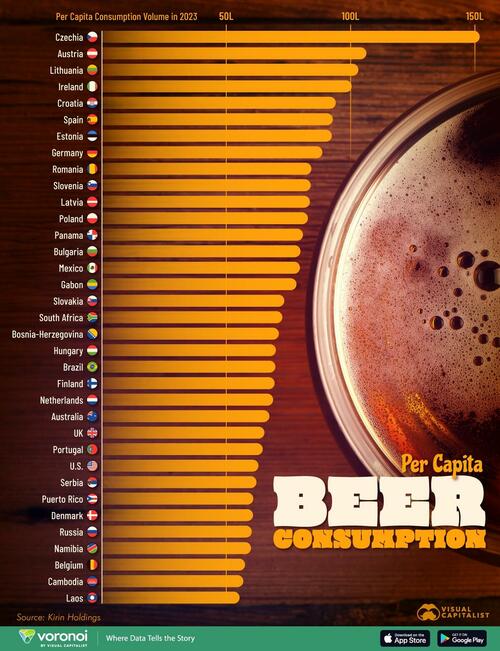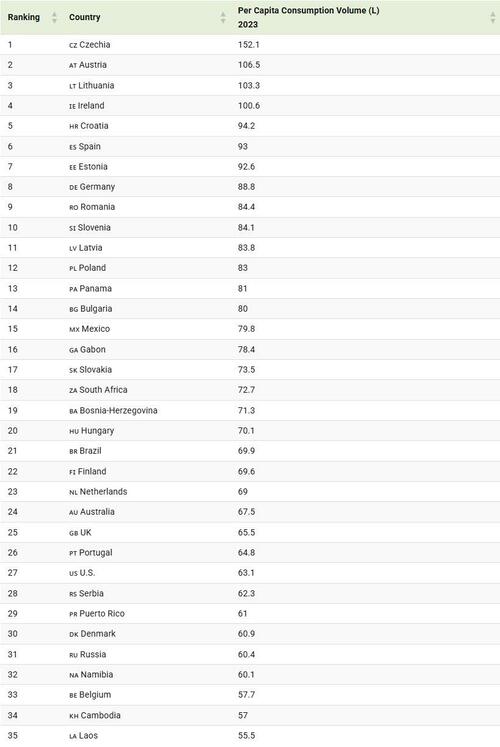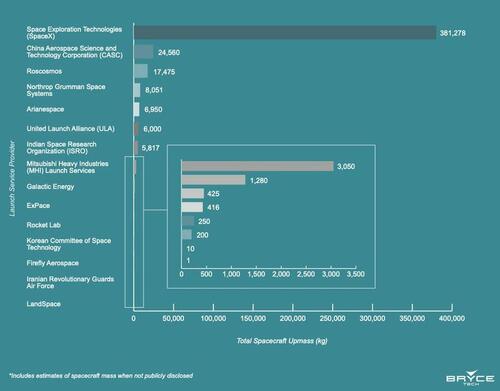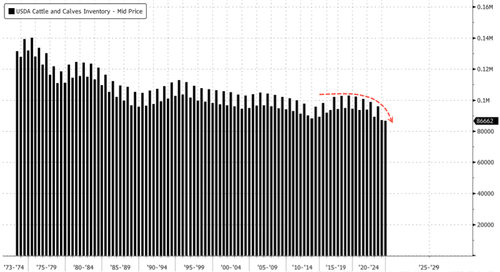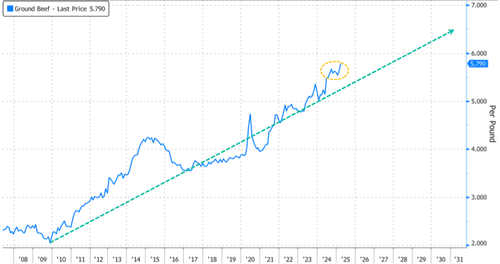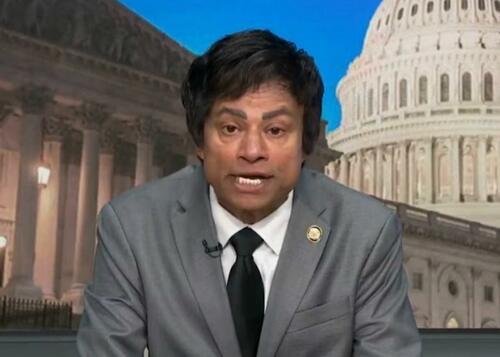The Eucharist is "the source and summit of the Christian life."
Distinction Matter - Subscribed Feeds
-
Site: Zero HedgeThe EU Zombie Uses Trump As Cover To Further Feed On CitizensTyler Durden Tue, 05/06/2025 - 06:30
Authored by Conor Gallagher via NakedCapitalism.com,
Donald Trump is the gift that keeps on giving for the western misleadership class. Any anti-democratic swindle on the EU wish list is now being sold as a remedy to the Orange Man. (And if it’s not Trump, it’s Russia).
The US is no longer a reliable defense partner, they say.
We must give more power to Brussels and send untold billions to weapons companies.
The US is no longer a reliable economic partner, they say.
We must increase competitiveness by weakening labor and empowering finance.
The UK voters may have opted for Brexit, but London and Brussels are “defying Trump” with a “free and open trade” declaration that includes negotiations ‘on defense and security, fishing and energy, as well as a “common understanding” of which topics will be covered by intensive Brexit reset negotiations this year.’
The strange thing about these plans, however, is that they include reliance on US weapons and energy and alignment with US geopolitical and geoeconomic goals.
Let’s focus here on how the EU is pressing ahead with plans to dramatically increase defense spending due to Trump Abandonment Syndrome.
The EU Jazz Band
Recent commentary by Rosa Balfour, director of Carnegie Europe, perfectly sums up these arguments. In a piece titled “Europe Tried to Trump-Proof Itself. Now It’s Crafting a Plan B” she explains why the EU has no choice but to redirect social spending towards the arms industry.
Balfour’s romantic version of recent history starts on February 28. That’s when “the televised humiliation of Ukrainian President Vladimir Zelensky” took place, and “Europe realized it could no longer rely on its longtime ally, the United States.” And here she is on the jazzy wreckage:
The shocking depth and breadth of this realization cannot be overemphasized. Political leaders in European states, the European Union, and NATO displayed composure and coordination, but behind the scenes, the soundtrack was a frantic free jazz jam session with dramatic thuds and a long pause—the silence at the realization that the European comfort zone was over.
And now, what are these composed and coordinated “political leaders” doing? They announce that Ukraine is Europe’s first line of defense, make grand plans for a “coalition of the willing,” and declare that Ukraine will become a “steel porcupine”
The coalition of the willing has fallen apart. The steel porcupine was ridiculed. And while those in the Kremlin likely aren’t losing any sleep, Europeans should be. That’s because, as Balfour writes, the European Commission “can play supporting roles by mobilizing financial resources and handling complicated in-house horse trading.”
That’s one way of putting it.
The Commission is inching its way towards invoking emergency powers to push through parts of its rearmament slush fund. It’s getting pushback from the European Parliament, but the fact is Ursula can do it anyways with minimal support from EU governments. She’s likely just waiting for the right moment. Let’s look at the status of the European militarization billions.
On March 19, the Commission introduced a 150 billion euro proposal — a first installment of what’s to be at least $900 billion— for establishing the Security Action for Europe (SAFE) through the reinforcement of European defence industry Instrument.
It wants to move forward with it under Article 122 emergency powers which need only a qualified majority in the Council —as opposed to the usual consensus— which allows Ursula and friends to get around pesky vetoes from member countries. The procedure for 122 is as follows:
1) the Commission proposes a Council measure; following which 2) the Council adopts the measure in line with [qualified majority voting]. No additional elements or participants are envisaged.
This article allows the proposal to bypass parliamentary negotiations and go straight to the Council for negotiation and adoption. The Parliament’s role is reduced to submitting suggestions and requesting debates.
How’s that for your democratic rules-based order?
In an April 23 secret vote, the European Parliament’s Committee on Legal Affair unanimously backed a legal opinion rejecting the Commission’s attempt to bypass it on a 150 billion euro rearmament fund.
While it is a non-binding vote, it does signal opposition to Ursula’s plan, but it’s not some principled stand for the will of the people or any romantic notion like that.
No, it’s more about dividing up slices of the pie as European weapons industry lobbyists are increasingly active in Brussels and are trying to make sure their clients are rewarded. And so much of the feeble opposition is over getting a stronger “buy European” clause in SAFE (it currently requires 65 percent of war consumables and complex systems to come from within the EU, Ukraine, or EEA/EFTA states, which includes Turkiye and Norway.
Why must Ursula’s commission sideline the Parliament and some member states in order to spend 900 billion on military purchases? They lay it out in their proposal. There’s the usual nonsense about Russia:
The EU and its Member States now face an intensifying Russian aggression against Ukraine and a growing security threat from Russia. It is also now clear that this threat will persist in the foreseeable future, considering that Russia has shifted to a war-time economy enabling a rapid scaleup of its military capabilities and replenishment of its stocks. The European Council therefore underlined, in its conclusions of 6 March 2025, that “Russia’s war of aggression against Ukraine and its repercussions for European and global security in a changing environment constitute an existential challenge for the European Union”.
There’s also the Trump abandonment syndrome:
At the same time, the United States, traditionally a strong ally, is clear that it believes it is over-committed in Europe and needs to rebalance, reducing its historical role as a primary security guarantor.
One itching question is what happens to this latter selling point now that the Trump administration has tied itself to Ukraine through the so-called minerals deal, but surely if the European powers have made it this far on manufactured crises, they’ll be able to overcome that hurdle by pointing to Trump’s insistence on what they call an unjust peace for Ukraine.
And so “rearmament” by supranational emergency decree it must be—with Balfour from Carnegie and all the other plutocrat court jesters at the transatlantic think tanks cheering this on as a victory against the autocratic hordes outside the garden walls. Here’s Balfour again summarizing the mood among this crowd:
…a trajectory of change has been charted, and it has transformative potential—not just for the European continent, but also for the global reordering of post-American international relations. The jazz band has picked up rhythm, even if the melody is not fully harmonic.
I’m not sure if that’s music Balfour is listening to or the jangle of gold and silver. While it can be difficult to hear anything over the din coming from the elite ‘Spirit of 1914,’ there’s always one chord missing from the militarization genre. Surely Balfour, the jazz aficionado, must know that curiosity was considered one of the essential ingredients to the music. If we apply that to her extended jazz metaphor we might start asking some questions like:
-
Why does the EU need to perform this whole militarization song and dance routine at all?
-
Why can’t there be peace with Russia?
-
Why did European nations help sabotage past Kiev-Moscow peace negotiations?
-
Why did the EU help the US overthrow the government of Ukraine and use the country as a battering ram against Russia?
-
Why does the EU elite so crave war with Russia?
-
Is the EU not more secure and prosperous through friendly ties and trade with Russia?
And why must the EU, which collectively already ranks second in the world in defense expenditures, spend boatloads more? How much will make it safe, competitive, and independent?
These questions are never addressed. It’s simply treated as the natural order of things that Russia is the EU’s enemy and it must get big expensive weapons because Trump bad. The sad thing is, this relentless messaging pumped out of European media is working — at least according to the EU’s own polls. That wouldn’t be entirely surprising considering this message is endlessly pumped out of EU media.
Either way, European governments are running with it. Sixteen countries are asking the EU for fiscal leeway to spend big on defense — requests that are never made during the endless social austerity.
Yes, the citizens of the bloc will continue to see their standard of living fall, but don’t worry, EU enlargement and spending more on militarization will lead to more “competitiveness.” Can’t you feel it already:
Profit margins for Weapon and Ammunition at Rheinmetall went up from 23% to 28.5% from 2023 to 2024. Of every Euro in public money spent on weapons from Rheinmetall, the company makes 28.5% return on sales, quite spectacular even compared to other Rheinmetall business. pic.twitter.com/SvKmjNcB30
— Isabella M Weber (@IsabellaMWeber) April 28, 2025Despite considerable hurdles for the European defense industry (and a brief cooling off period due to tariff shock), their stock prices are going through the roof as investors expect Brussels to come through with endless support.
About those hurdles…
Research by the Stockholm International Peace Research Institute (SIPRI) shows that Europe increased its imports of weapons two-and-a-half times over in the past five years compared with the previous five years with two-thirds coming from the US.
Even others at Carnegie Europe have doubts about the EU scheme. Here’s Judy Dempsey, nonresident senior fellow at Carnegie Europe:
Tell Poland. It is rapidly building up its defense infrastructure by purchasing American kits. When Warsaw wanted to shop elsewhere, like in South Korea, it came under huge pressure from Washington not to do so. This is an important point. The United States wants Europe to take more responsibility for its defense but not at America’s military industrial expense. It is a major military supplier of components to many European countries. Making that break would take time and a political will for Europe to build up a common defense and procurement strategy.
Beyond the considerable political pressure, there’s also the fact that lead times when it comes to defense capabilities are long. So part of the EU’s strategy is to send billions more to Ukraine so it can build up its defense industry. The rationale is that it is a far cheaper place to manufacture weapons than Western Europe, and it already has a defense manufacturing sector up and running. Okay, then.
But are there some chinks in that logic?
For one, Ukraine is now the world’s biggest arms importer, absorbing 8.8 percent of global transfers. Two, Russian Kinzhals might have a say in the output from Ukrainian weapons manufacturers.
It’s hard to see what this all does for European competitiveness, let alone the average Josef, Jose, or Giusseppe. Here’s Balfour on this should be sold to the proles:
Politically, to ensure public support for rearming Europe and to offset the inevitable costs, defense efforts ought to be part of a broader strategy of economic and technological innovation. Indeed, these efforts could boost Europe’s stagnant economy. At the EU level, the recipes are available in recent recommendations addressing competitiveness, productivity, and technological innovation.
Indeed, Trump’s first 100 days are pushing the EU to put some momentum behind projects that have been underway for years. Tying these objectives with the enlargement of the EU to include Ukraine, Moldova, and the Western Balkans adds a new perspective to upscaling the single market. Expanding the EU and deepening the relationship with other European countries—like the UK, Switzerland, and Norway—would counter the fragmentation that great power competition and political disruption at home are inflicting on the continent.
It’s scary for its rote, simplistic confidence. Nowhere in this hopeful Powerpoint is there an appearance of the considerable downsides, which at the more disastrous end of the spectrum happen to include the complete destruction of Europe.
Perhaps the best hope is that these fools’ plans for EU rearmament plans are just a giant racket. But one could say the same about the US military industrial complex, and look at what that has unfurled: endless death and destruction and numerous lost wars. One key difference between the transatlantic militarization schemes, however, is that the US is isolated between two oceans. The EU borders not only Russia, but also a collapsing neo-Nazi regime in Ukraine, making its embrace of a military-industrial complex a far riskier proposition.
Rackets have a way of taking on a life of their own. Indeed, one could argue the EU’s current trajectory is that of a zombie driven along by its Russophobia — and redistributing money upwards in the name of that hatred. Problem is that life expectancy isn’t long for zombies and those around them.
-
-
Site: Zero Hedge"We Are At A Tipping Point": Shale Giant Diamonback Says US Oil Output Has Peaked, Slashes CapEx Amid OPEC Price WarTyler Durden Tue, 05/06/2025 - 06:15
The OPEC price war has made landfall in the US.
Following our report earlier that Saudi Arabia has declared a new price war on OPEC+ quota-busters such as Kazakhstan, and non OPEC+ members such as US shale producers, today after the close Diamondback Energy, the largest independent oil producer in the Permian Basin, made a historic pronouncement today when it said that production has likely peaked in America’s prolific shale fields (something we also mentioned earlier in the day) and will decline in the months and years ahead after crude prices plummeted.
Separately, the Texas company trimmed its own full-year production forecast Monday, and said that it expects onshore oil rigs across the entire US industry to drop by almost 10% by the end of the second quarter and fall further in the months after.
“This will have a meaningful impact on our industry and our country,” Diamondback Chief Executive Officer Travis Stice wrote. “We believe we are at a tipping point for U.S. oil production.”
The outlook from Diamondback, one of the industry’s most prominent producers, marks a key shift for expectations within the sector. Before oil prices started plunging last month, most banks and research firms had forecast US shale production would grow this year and next before plateauing later in the decade. The Permian, they said, was apt to peak in the late 2020s or early 2030s depending on prices.
Not any more.
As Bloomberg notes, the US shale fields have been the engine behind the surge in US crude output over the past 15 years, making the country the world’s top producer and largely energy independent, much to the horror of OPEC. The ability of companies like Diamondback to quickly bring new wells online using hydraulic fracturing, also known as fracking, has bedeviled OPEC. But the prospect that shale may now have reached its peak and is facing years of painful decline, poses a huge threat to US President Donald Trump’s goal to turbocharge fossil fuel production.
While analysts and pundits have long said repeatedly that US shale is poised to peak, the industry had managed to prove them wrong by innovating and driving output to fresh records year after year.
So the assertion by Diamondback that the moment has finally come is extremely noteworthy.
“Today, geologic headwinds outweigh the tailwinds provided by improvements in technology and operational efficiency,” said Stice, who will step down as CEO at the company’s annual shareholder meeting later this month.
US oil futures, pricing in a global demand recession, have dropped about 20% since the start of April when Trump announced wide-ranging tariffs that triggered a global trade war. At the same time, OPEC and its allies have surprised markets with plans to increase oil supplies more than expected later this year in response to internal bickering, and particularly the unwillingness of some members such as Kazakhstan to comply with set production quotas.
It’s led to frustration spilling out both privately and in public comments from America’s oil bosses. US Energy Secretary Chris Wright sought to reassure the industry during a visit to Oklahoma last month, saying turmoil from the president’s trade war is likely to be fleeting.
“We can’t help but wonder if the last ‘letter to stockholders’ written by outgoing CEO Travis Stice was intended as much for government leaders in Washington, DC as it was for FANG shareholders,” Tim Rezvan, an analyst at KeyBanc Capital Markets wrote in a note to clients.
Diamondback said the number of crews fracking wells, which it estimates has fallen 15% this year, will continue to shrink as shale operators dial back amid unprofitable oil prices.
The company now expects to produce about 488,000 barrels of oil per day this year, when taken at the midpoint of its new guidance released Monday. That’s less than 1% lower than the roughly 492,000 barrels-per-day view it gave three months ago.
The driller is the latest US operator to announce cutbacks in recent months. EOG Resources and Matador Resources are also dialing back activity, while Nabors Industries said that shale producers plan to cut 4% of their drilling rigs by the end of the year, citing a survey of nearly half the industry.
For the immediate future, Diamondback is cutting three drilling rigs and one of its frack crews, leading to a total of $400 million slashed from its budget this year, Stice said, the clearest indication that US output is about to fall off a cliff, because if the most efficient and lowest cost producers have no choice but to throttle output what does that leave for the smaller, less efficient frackers?
“We are taking our foot off the accelerator as we approach a red light,” Stice said. “If the light turns green before we get to the stoplight, we will hit the gas again, but we are also prepared to brake if needed.”
-
Site: Mises InstituteIndia claims it is attacking "terrorist infrastructure." Both countries have nuclear weapons.
-
Site: Real Investment Advice
An email from a reader of ours led with the title "PCE is quite confusing." He asked if we would explain the difference between the monthly PCE prices index and the quarterly PCE prices, i.e., the GDP deflator, accompanying the GDP report. Given the importance of monthly PCE prices to the Fed and their meeting tomorrow, it's worth answering the question publicly.
Last week, we learned that the quarterly PCE price deflator was up 3.7% on an annualized basis. However, monthly PCE prices were flat. While the two inflation measures share the same name, PCE (personal consumption expenditures), they measure different things. Monthly PCE prices, the Fed’s favored inflation gauge, track price changes in consumer goods and services. The quarterly PCE price gauge is an index designed to subtract the impact of inflation from the GDP figure to arrive at real GDP. Accordingly, the deflator uses a broader measure of goods and services, including items not directly tied to household spending.
Of additional consideration, the quarterly PCE is more prone to large revisions than the monthly data. Thus, the monthly reading is more reliable. The graph below shows that the two inflation gauges track each other well on an annualized basis. However, there is a slight gap at the moment between them. While month PCE prices fell by 0.04% last month, they were up .44% and .30% in the prior two months. Thus, its quarterly annualized change is approximately 3.1%, not as much of a divergence as the recent PCE data portends.

What To Watch Today
Earnings

Economy

Market Trading Update
Yesterday, we noted the recent technical setup suggests a near-term correction after a sharp rally from the "Liberation Day" woes. Despite the short-term overbought conditions, corrections will likely remain contained above recent support levels for a couple of reasons. The first, as noted on "X," the share repurchase (stock buybacks) window has now reopened, and the sharp rise in buybacks has provided the necessary support for the recent rally. Those buybacks will continue through May.

Secondly, the breadth of the market has improved markedly. As shown, market breadth has improved significantly with the number of stocks trading above their 50 and 200-DMA rising sharply, and the NYSE Advance-Decline line testing previous highs.

This data suggests that while corrections are likely, they should be well contained to previous broken-resistance levels, turning them into support. The weekly sell signal in the bottom panel is one thing to watch closely. When that signal reverts to a buy, it will be time to return equity exposure to target weights. For now, while a correction back to recent lows is possible, the higher probability is that any correction that reverts the market toward 5500 or 5300 will likely find buyers willing to step in.

However, with that stated, it is certainly possible that later this summer, as the impact of tariffs is fully recognized, the economy slows, and earnings are revised lower, the market will likely encounter another volatility spat. As I noted in yesterday's blog on "Resistance Is Futile:"
If you want my best guess, here it is:
- We’ve likely seen the market lows for this year.
- We’ve likely seen the highs as well.
Navigating a market trapped between support and resistance becomes emotionally challenging. Investors face sharp rallies into resistance — and retracements back to support — wearing down sentiment until mistakes happen.
Therefore, this is how we are positioned in this current and uncertain market environment.
- Primarily long equities, as the market structure remains bullish.
- Increased cash levels to manage policy and growth uncertainty.
- Short S&P 500 index to hedge downside risk.
We also recommend a healthy portfolio and risk management regimen.
- Tighten up stop-loss levels to current support levels for each position.
- Hedge portfolios against more significant market declines.
- Take profits in positions that have been big winners.
- Sell laggards and losers.
- Raise cash and rebalance portfolios to target weightings.
Here’s the hard truth: you can’t measure risk in advance.

Sectors Rotate Down And To The Right
Within the first SimpleVisor screenshot below, the graph to the right of the sector absolute and relative analysis charts the movement of each sector score over the last two weeks. Interestingly, we notice that many sectors' paths have moved down and to the right. Consequently, the absolute scores are increasing for those moving in that direction, while the relative scores generally decrease. In other words, most sectors are seeing their technicals improve but are underperforming the market.
The second graphic shows that despite the decent rally over the last few weeks, many absolute and relative scores remain near fair value. Typically, we would expect to see higher absolute scores. This is a sign the market remains cautious. However, if the market continues to rally, there remains a decent amount of upside before sectors and factors become overbought on an absolute or relative analysis.
The second graphic shows that the Momentum ETF is very overbought versus the S&P 500. The third graphic breaks down its holdings. As you can see, some of its largest holdings are decently overbought on an absolute and relative analysis.



Resistance Is Futile For Bulls And Bears
“Resistance is futile” was a sentence that struck fear in the hearts of Trekkie fans during “Star Trek: The Next Generation,” specifically in both of the “Best Of Worlds” and “First Contact” episodes. In those episodes, the “Starship Enterprise” crew encountered a species called the “Borg.” The Borg’s primary purpose was to achieve “perfection” by assimilating other beings and technologies into their “hive mind,” known as the “Collective.” They viewed assimilation as a means to expand their collective knowledge, power, and ultimately, their vision of a perfect and harmonious existence. The reason “resistance was futile” was that the centralized control, driven by the Borg Queen, allowed for swift and coordinated actions across vast distances. At the same time, the assimilation process threatened to erase individuality and homogenize the galaxy.
I could go on, but you are asking yourself two questions. First, is Lance a total sci-fi geek? Second, what does this have to do with the markets and investing? The answer to the first question is “yes,” as I grew up with William Shatner as James T. Kirk in the original Gene Roddenberry “Star Trek.”
However, let’s dig deeper into the second question. READ MORE...

Tweet of the Day

“Want to achieve better long-term success in managing your portfolio? Here are our 15-trading rules for managing market risks.”
Please subscribe to the daily commentary to receive these updates every morning before the opening bell.
If you found this blog useful, please send it to someone else, share it on social media, or contact us to set up a meeting.
The post PCE Is Quite Confusing appeared first on RIA.
-
Site: Catholic Herald
May, the month of Our Lady, invites us to deepen our Marian devotion. While the rosary and scapular are familiar to many, one ancient practice, the Little Office of the Blessed Virgin Mary, has mostly faded from common use.
This devotion, a compact, Marian-focused office, small enough to fit in your pocket, follows the same daily “hours” as the traditional Divine Office (e.g. Matins, Lauds, Vespers etc) with fixed prayers and psalms, offering a rhythmic, meditative way to honour Our Blessed Mother.
The Little Office boasts remarkable antiquity, particularly in England, where it was cherished for centuries. Its brevity and daily familiarity made it accessible to the laity. Historical accounts describe mothers, little children and schoolboys chanting this office as they go about their daily duties.
Like many ancient devotions, its origin is shrouded in mystery, but by the 8th Century we have examples of offices devoted to the Blessed Virgin in both the East and the West. The Little Office entered the Benedictine tradition through the reforms of Benedict of Aniane, who added additional offices before and after the Divine Office, including that of the Blessed Virgin Mary.
Thanks to the Benedictine revival in England in the 10th Century, many churches and cathedrals adopted the customs of monasteries of the continent which included these additional offices. England’s fervent Marian piety, evident in its title as “Our Lady’s Dowry”, was the perfect kindling for the Little Office to spread.
By the 11th century, Pope Urban II mandated it as an obligatory addition to the Divine Office for clerics universally, a decree announced at the 1095 Council of Clermont alongside his call for the First Crusade. This elevated the Little Office’s status across the West, cementing its place in liturgical life.
The faithful of 13th century Paris, were said to have been drawn to the daily reciting of the Little Office in Notre Dame, finding solace in its repetitive prayers and chants, which, as one observer noted, offered “great comfort to all present”.
By the 15th century, King Henry VI, a devotee, included in the founding statutes of Eton College that the boys, upon rising and making their beds, should say the Matins of the Blessed Lady. A 1496 report by a Venetian ambassador described English women carrying rosaries and “the Office of Our Lady”, while St. John Fisher, in his funeral sermon for Lady Margaret Beaufort, mother of Henry VII, shared that she would rise every morning to say the Matins of Our Lady.
Whilst the Council of Trent lifted the clergy’s obligation to pray the Little Office on top of their breviary, “on account of the various businesses of this life”, it was the laity and some religious orders that kept the tradition alive. In England, it became a cornerstone of the primer, a vernacular prayer book for lay people. During the Reformation, these primers sustained persecuted Catholics, who clung to the Little Office as a lifeline of faith. Its prayers, often in English, offered solace amid suppression.
The Little Office experienced a revival following the 1850 restoration of the Catholic hierarchy. James Burns’ 1860 translation made it widely accessible, and Pius X’s 1911 reforms standardised the version used today.
Following the liturgical reforms after the Second Vatican Council, however, many switched to the more streamlined ‘Liturgy of the Hours’, which removed the need for a shorter office, nearly extinguishing this noble devotion by the end of the century.
It wasn’t until Pope Benedict XVI’s 2007 motu proprio, Summorum Pontificum, which permitted a wider use of the traditional Roman Breviary, that this devotion started to be revived once again. Today, the Little Office is available from publishers like Baronius Press, whose edition includes Gregorian chant notations. Online resources, including YouTube tutorials, teach the chants, making it easier than ever to learn, and a perfect entry point for liturgical chant.
The daily repetition, far from monotonous, fosters a meditative rhythm. As Blessed Ildefonso Schuster wrote, it draws us into “the endless land where the Church, militant and pilgrim, passes, walking towards the promised fatherland”.
For Catholics today, the Little Office offers a unique bridge between personal devotion and the Church’s ancient liturgy. The Little Office immerses us in psalms and hymns that exalt Mary’s role in salvation history. Its structure can be adapted to busy schedules, with many praying only morning Lauds or evening Vespers.
The Little Office has survived near extinction before; through persecution, reform and neglect. A revival in England, Our Lady’s Dowry, would be especially fitting. May is the perfect time to draw close to Mary and it is now easier than ever to pick up this treasure of the Church, one that offers a timeless path to the Immaculate Heart of Mary.
Photo: O Mary, Conceived Without Sin, Pray for Us Who Have Recourse to Thee (2 January 1915)

The post The Little Office of the Blessed Virgin Mary: England’s forgotten devotion first appeared on Catholic Herald.
The post The Little Office of the Blessed Virgin Mary: England’s forgotten devotion appeared first on Catholic Herald.
-
Site: Real Investment Advice
Rising interest rates are a powerful force in the financial world, capable of reshaping markets and shifting investment dynamics. As the Federal Reserve raises rates to combat inflation or stabilize economic growth, the ripple effect is felt across stocks, bonds, and real estate. While these rate hikes may be out of investors’ control, adapting your investment strategy can help you manage risks and even uncover new opportunities.
How Rising Interest Rates Affect Different Asset Classes
Stocks
Interest rate increases typically lead to higher borrowing costs for companies, which can reduce profit margins and curb growth. This especially impacts growth stocks—like tech companies—that rely on borrowing for expansion. On the other hand, sectors like financials (banks, insurance companies) may benefit, as they tend to profit from higher lending rates.
Rising rates can also dampen investor sentiment and reduce stock valuations, as future earnings are discounted more heavily. This can result in short-term volatility, even if long-term fundamentals remain strong.
Bonds
The bond market is perhaps the most directly affected by rising rates. When interest rates rise, bond prices generally fall. That’s because newly issued bonds pay higher interest, making existing bonds with lower rates less attractive.
Long-duration bonds are especially vulnerable. However, this doesn’t mean investors should avoid bonds altogether—shorter-term bonds or bond laddering strategies can help mitigate interest rate risk while still providing income.
Real Estate
Rising interest rates often lead to higher mortgage rates, which can reduce demand for housing and slow price appreciation. For investors in real estate investment trusts (REITs), rising rates may lead to declining property values and increased costs for leveraged properties.
However, not all real estate reacts the same way. Commercial real estate with strong lease structures or properties in high-demand areas may remain resilient. Additionally, real estate can still serve as an inflation hedge, especially if rental income keeps pace with rising prices.
Strategies for Adapting Your Investment Portfolio
To weather rising interest rates, investors may need to adjust their approach and rebalance their portfolios with long-term resilience in mind.
Adjust Asset Allocation
A diversified portfolio is always a good foundation, but rising rates may prompt a closer look at your current asset mix. Reducing exposure to long-duration bonds, rebalancing stock holdings, and considering rate-sensitive sectors (like financials or energy) can help offset interest rate risks.
Explore Short-Term and Floating Rate Bonds
Shorter-duration bonds or floating-rate bond funds offer more protection in a rising rate environment. These bonds mature sooner or have rates that adjust periodically, making them less sensitive to rate hikes.
Look for Dividend-Paying Stocks
Dividend-paying stocks—particularly those from companies with strong balance sheets—can offer a buffer during volatile periods. These companies often have pricing power, allowing them to maintain profitability and continue returning value to shareholders.
Reassess Real Estate Holdings
If your portfolio includes real estate investments, review the debt structures and geographic markets of your holdings. Consider diversifying into REITs with shorter lease durations or sectors like industrial or healthcare, which may show greater resilience.
Maintain Liquidity and Flexibility
Keeping a portion of your portfolio in liquid, low-risk investments allows you to take advantage of opportunities as they arise. Higher interest rates may bring volatility, but also the chance to buy quality assets at more attractive prices.
Turning a Challenge Into Opportunity
While rising interest rates can pose challenges, they also create new opportunities for informed investors. By reassessing risk exposure and considering alternative income strategies, it’s possible to protect your portfolio while positioning for growth.
Higher interest rates don’t have to derail your financial goals. With a proactive, diversified, and disciplined investment strategy, you can confidently navigate the shifting landscape.
Looking to adapt your investment strategy for a changing rate environment?
Contact RIA Advisors today to schedule a consultation. Our fiduciary team will help you build a portfolio designed to manage risk, preserve capital, and uncover opportunities—no matter what the market brings.
FAQs
How do rising interest rates affect bond investments?
Rising rates generally cause bond prices to fall, especially for long-duration bonds. Short-term or floating-rate bonds can help mitigate this risk.
Are stocks still a good investment during rising interest rates?
Yes, but certain sectors may perform better than others. Financials and dividend-paying stocks often fare well, while high-growth tech stocks may be more vulnerable.
Should I change my real estate investments when rates go up?
It’s worth reviewing your real estate holdings. Properties with shorter lease durations and REITs in resilient sectors may offer better stability.
What is the best fixed-income strategy for rising rates?
Short-duration bonds, bond ladders, and floating-rate bond funds can offer income with lower interest rate risk.
Can rising interest rates create investment opportunities?
Yes. While volatility may increase, rising rates can improve yields on new bonds and create value in previously overvalued sectors.
The post The Impact of Rising Interest Rates on Investments and How to Adapt appeared first on RIA.
-
Site: Crisis Magazine

Many who have written on the needed characteristics of the next pope have said such things as “The next pope needs to call the bishops to proclaim the faith boldly; to restore respect for the sacraments; to unify the polarized elements of the Church.” Few pundits note that purging the Church of the Lavender Mafia, of the homosexual priests and bishops who run the Church, is arguably the most…
-
Site: RT - News
Germany’s main political parties have failed to elect an agreed candidate as chancellor in a historic moment for the EU nation’s politics
A proposed coalition of Germany’s liberal and conservative parties has failed to elect a chancellor in a German parliament first round vote.
Frederich Merz, the Christian Democratic candidate who was also backed by the liberal SPD, garnered 310 votes on Tuesday, falling six short of the 316 needed for an absolute majority. The session was adjourned for consultations among political groups regarding their next steps.
According to German media, the vote failure marks the first time in Germany’s post-war history that a chancellor candidate has been thwarted in such a manner.
Merz’s proposed coalition, comprising his CSU/CDU bloc and the German Social Democrats (SPD), holds 328 seats in the Bundestag.
Should Merz – or potentially another candidate – fall short in a second round held within two weeks, the procedure would go to a simple majority vote, after which the German president must appoint the winner as chancellor or dissolve the legislature.
READ MORE: Labeling the AfD ‘extremist’ will backfire terribly
Germany’s previous three-way ruling coalition led by the SPD collapsed last November due to disagreements over spending. The new proposed coalition has pledged to continue key elements of former Chancellor Olaf Scholz’s agenda, including support for Ukraine and unlocking a constitutional debt brake in militarization.
Last week, Germany’s domestic intelligence agency, the BfV, designated the Alternative for Germany (AfD) party as “extremist.” The right-wing, anti-migrant movement is currently polling on par with the Christian Democrats for voter preference in a potential federal election. The AfD’s leaders have claimed that the “extremist” designation was politically motivated and aims to undermine the party’s rising popularity.
-
Site: AsiaNews.itToday's News: Japan, China, South Korea, and ASEAN nations launch a new emergency loan agreement to safeguard regional financial stability. Former South Korean PM Han backs the PPP candidate for a united conservative front ahead of the June 3 vote. The UN urges 'maximum restraint' between India and Pakistan, while the OIC expresses 'concern'.
-
Site: AsiaNews.itThe goal of the program is to help inmates return to a "dignified life" in society. The state is prepared to allocate nearly $3.6 million for a five-year plan. The real threat of radicalization arises within prison walls. The exponential increase in convictions is linked to the political class's crackdown on dissent.
-
Site: Crisis Magazine

It is jarring to read the recent letters Palestinian Christian leaders have sent directly to the United States Conference of Catholic Bishops (USCCB) pleading with them to stand in solidarity with the suffering Church in Gaza and the West Bank. “Homes, churches, and hospitals have been destroyed,” they wrote in a letter just this month. In an earlier letter, dated March 25…
-
Site: Mises InstitutePresident of the Mises Institute Tom DiLorenzo joins Saifedean Ammous on The Bitcoin Standard Podcast to discuss his work on US history and economics, and the increasing influence of the Mises Institute and Austrian school economics.
-
Site: Zero HedgeUS Approves $310M Training & Sustainment For Ukraine's F-16s After Minerals Deal SignedTyler Durden Tue, 05/06/2025 - 05:00
Authored by Dave DeCamp via AntiWar.com,
The State Department has approved a potential $310.5 million arms sale to Ukraine for training and sustainment of the country’s fleet of US-made F-16 fighter jets, signaling that the Trump administration is preparing to provide long-term military support.
The Pentagon’s Defense Security Cooperation Agency (DSCA) said the sale will include aircraft modifications, upgrades, personnel training, maintenance, sustainment support, and other types of equipment.
 Image: Office of the Ukrainian President
Image: Office of the Ukrainian President
Several of the US’s European allies have provided Ukraine with F-16 fighter jets, and the US, under the Biden administration, was involved in training Ukrainian pilots. A report from The War Zone just revealed that the US has been providing Ukraine with decommissioned, non-operational F-16 fighter jets.
A US Air Force spokesman told The War Zone that the Air Force has "supported the sustainment of European-donated F-16s to Ukraine by providing disused and completely non-operational F-16s to Ukraine for parts."
"These F-16s were retired from active US use and are not flyable. Importantly, they lack critical components such as an engine or radar and could not be reconstituted for operational use," the statement said.
The approval of the F-16 training and sustainment deal came a few days after the Trump administration moved forward with its very first arms sale for Ukraine by notifying Congress of its plans to approve the export of unspecified "defense articles" worth $50 million or more.
That first sale is being moved forward as a direct commercial sale (DCS), a deal where the State Department gives a private company permission to sell weapons directly to a foreign government. The F-16 training and sustainment deal is a Foreign Military Sale (FMS), which involves the US government in the sale.
The US-Ukraine minerals deal signed last week also signals that the US is planning to provide long-term military support.
U.S. President Donald Trump says "tremendous hatred" between Russia and Ukraine may block peace talks. Saying 5,000 soldiers per week are dying, Trump said “if I can save 5,000 souls, I just love doing it."#UkraineWar #Trump #PeaceTalks #RussiaUkraine pic.twitter.com/dJwT2zMiei
— CGTN Europe (@CGTNEurope) May 5, 2025Under the agreement, future US military aid will count as a contribution to a joint US-Ukraine investment fund. Critics have said this ensures the US is even more intertwined in Ukraine's fate.
-
Site: Rorate Caeliby Kevin Tierneyfor Rorate CaeliMay 6, 2025Thomas Cole, Desolation (1836)On May 7th, 2025, the world will turn its attention to Rome for the papal conclave to elect a successor to Pope Francis. In a certain way of looking at things, it is a reminder that Catholicism, and only Catholicism, can capture the attention of the world when it comes to Christianity. That even her foes New Catholichttp://www.blogger.com/profile/04118576661605931910noreply@blogger.com
-
Site: Zero HedgeGlobal Press Freedom Indicator SlipsTyler Durden Tue, 05/06/2025 - 04:15
This year's World Press Freedom Index highlights the economic situation of journalists and media organizations being a major risk to press freedom, as "today’s news media are caught between preserving their editorial independence and ensuring their economic survival".
Due to the economic indicator of the index decreasing by more than two points in one year and the other subindices measuring the security, social, political and legal situation of the press also losing at least some ground since 2024, the overall index entered into "difficult" territory for the first time in 2025.
"Without economic independence, there can be no free press. When news media are financially strained, they are drawn into a race to attract audiences", Anne Bocandé, RSF's Editorial Director said.
Statista's Katharina Buchholz reports that in 160 out of the 180 countries included in the report, media outlets reported achieving financial stability only “with difficulty” or “not at all.” In a third of all countries, significant news outlets shutting down were recorded, extending to developing and developed countries.
You will find more infographics at Statista
In the U.S., the indicator dropped much more than the global average, by 5.4 points, and news deserts where local media coverage lacks were becoming the norm, the report states.
Additionally, the report claims that Trump administration cuts to the U.S. Agency for Global Media, affecting the Voice of America and Radio Free Europe/Radio Liberty newsrooms, added to economic difficulty and deprived over 400 million citizens worldwide of access to reliable information.
USAID cuts also affected journalists all over the world who had received funding, including in Ukraine.
The security, social and legal situation of journalists in a worldwide average continues to be rated as "not difficult", if only slightly so at ratings between 58 and 67 points (where anything under 55 signals a difficult situation). The political situation of global media has been rated as "difficult" since last year, while the economic situation of the press has been in difficult territory for longer.
However, in 2025, it reached a new low of just 44.1 points.
-
Site: RT - News
The US president indicated that he does not believe claims that Russia destroyed its own pipelines
US President Donald Trump has dismissed claims that Russia was behind the 2022 sabotage of the Nord Stream gas pipelines and suggested that the true culprit is widely known – without naming names.
Speaking at a White House press event, Trump said there was no need for a formal investigation to uncover who carried out the attack, which crippled a key energy route between Russia and Western Europe.
Three of the four Nord Stream pipelines, built to deliver Russian gas to Germany and the rest of Western Europe, were damaged by blasts at the bottom of the Baltic Sea in September 2022.
On Tuesday, a correspondent for libertarian financial blog ZeroHedge, which has been admitted to White House press events under the new administration, noted that Trump had previously rejected the Western narrative that Russia blew up its own pipelines, and asked the president if he was planning to initiate a probe to find out who was actually behind the attack.
Read more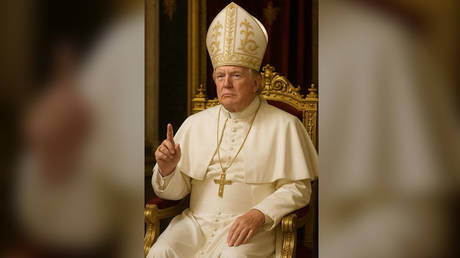 Trump responds to AI pope image criticism
Trump responds to AI pope image criticism
“If you can believe it, they said Russia blew it up,” Trump responded. “Well, probably if I asked certain people, they would be able to tell you without having to waste a lot of money on an investigation. But I think a lot of people know who blew it up,” he added, without elaborating.
ZeroHedge suggested that Trump’s comment meant that “based on classified intelligence he knows exactly who was behind” the destruction of Nord Stream. It also “should put the ‘Russia destroyed its own vital and economically lucrative pipeline’ storyline to rest,” the outlet insisted.
In early February 2023, veteran investigative journalist Seymour Hersh published a report claiming that then US President Joe Biden had given the order to destroy Nord Stream. According to an informed source who talked to the Pulitzer Prize-winning journalist, the explosives that were detonated on September 26, 2022 had been planted at the pipelines by US Navy divers a few months earlier under the cover of a NATO exercise called ‘Baltops 22’. The White House denied the report, calling it “utterly false and complete fiction.”
READ MORE: Trump to hit non-US films with 100% tariff
Senior Russian officials, including President Vladimir Putin, have previously pointed the finger at the US as the possible culprit behind the Nord Stream explosions. They have argued that Washington had the technical means to carry out the operation and stood to gain the most, considering that the attack disrupted Russian energy supplies to the EU and forced a shift to more expensive US-supplied liquefied natural gas.
-
Site: Mises InstituteThe antitrust lawsuit against Google by the United States Department of Justice (DOJ) seeks to dismantle the tech giant on the grounds that it has “monopolized the internet search market.” This is nothing but an overreach that shatters the very pillars of a free and competitive marketplace.
-
Site: Rorate Caeliby Aurelio Porfiri, in Romefor Rorate CaeliMay 5, 2025Rome, the city that seems indifferent to everything and everyone, awaits the Conclave with curiosity. A curiosity that often turns into folklore and is no longer lived in the light of faith. This concerns more and more people—not only in Rome. Precisely for this reason, the new Pope cannot avoid considering that the proclamation of the faith New Catholichttp://www.blogger.com/profile/04118576661605931910noreply@blogger.com
-
Site: Zero HedgeThe Czechs Are By Far The World's Biggest Beer DrinkersTyler Durden Tue, 05/06/2025 - 02:45
Today, Czechia officially recognizes beer culture as part of its national heritage, with 96% brewed domestically.
What’s more, Czechs hold the world’s highest per capita beer consumption, a tradition dating back to 993.
Similarly, Germany and Belgium also recognize beer culture as official heritage and rank among the top beer-drinking nations, thanks to its enduring place in their national cultures.
This graphic, via Visual Capitalist's Dorothy Neufeld, shows the countries that consume the most beer per capita, based on data from Kirin Holdings.
Czechia Ranks First in Per Capita Beer Consumption
For the 31st year in a row, Czechia tops the list, even amid an annual decline.
Notably, the original Budweiser traces its roots in the country, where beer from the South Bohemian region is called “Budweiser”. In 1876, a German immigrant in the U.S. adopted the name for his brewery, paying homage to the traditional Czech style.
Below, we show the top 35 countries with the highest beer consumption per capita:
Ranking in second is Austria, where pale lagers, known as “Märzen” are the standard beer.
Meanwhile, Lithuania and Ireland follow closely behind, where the average person drinks over 100 liters of beer in a year. In Ireland, Guinness is widely considered the national beer, with the original St. James Gate brewery now over 260 years old.
Interestingly, however, both the UK and Nigeria consume more Guinness than Ireland, thanks to their vibrant beer cultures. In fact, one in 10 beers sold in the UK is a Guinness.
If we look beyond Europe, Panama, Mexico, Gabon, and South Africa also rank among the top 20 countries
To learn more about this topic from a wine-based perspective, check out this graphic on which U.S. states consume the most wine.
-
Site: Mises InstituteThis slim book engagingly written encapsulates the basic lessons of money and of how it is deformed by government and central banking in a magical story that will charm and enlighten young readers.
-
Site: Zero HedgeEuropean Leaders Talk Of EU ArmyTyler Durden Tue, 05/06/2025 - 02:00
Authored by Mark Nayler via the Foundation for Economic Education (FEE),
Europe is once again talking about forming its own defense alliance. The idea of a European army—discussed on and off since the early days of the Cold War—was revived in February by Volodymyr Zelensky. The Ukrainian president claims that Donald Trump’s retraction of military support for Ukraine and ambivalence towards the EU shows that the bloc urgently needs its own military unit. Zelenskyy has reignited a debate that has failed to generate consensus within Europe, despite its long history.
Spain’s Socialist prime minister, Pedro Sánchez, is the latest EU leader to echo Zelenskyy—and according to a YouGov poll conducted in 2022, 64 percent of Spaniards are on his side. On March 28, he announced that Europe needs its own defense force to combat “old imperialist impulses in Russia,” especially in light of reduced support from the US. He called for a military force “with troops from all 27 member countries, working under a single flag with the same objectives.” Sánchez also wants greater economic integration within the bloc, and recently proposed a debt mutualization scheme—which has caused division along similar lines as the idea of a 27-nation army.
Despite Sánchez’s crusading rhetoric, one suspects there’s a self-interested motivation behind his call for an EU army. He is under intense pressure from both the EU and the United States to increase Spain’s defense spending; but anti-military sentiment in the country is strong, and he governs in partnership with Sumar, a leftist alliance that opposes increased investment in arms and troops. By claiming that EU defense is a collective, rather than national, responsibility, Sánchez no doubt hopes to deflect attention from his own difficulties.
The EU does collaborate on defense to some extent. At any one time, at least one multinational Battle Group, consisting of 1,500 troops, is on standby. These reached operational capacity in 2007, but according to the multinational military headquarters Eurocorps, “issues relating to political will, usability, and financial solidarity have prevented them from being deployed.” Precisely the same problems would arise within an EU army, of course—but on a much larger scale. There is also the European Maritime Force, formed in 1995 by Spain, France, Italy, and Portugal to conduct sea control, crisis response operations, and humanitarian missions. Advocates of an EU army argue that while these collaborative forces are an important pillar of the bloc’s defense, they are not equipped for long-running conflicts. They also claim that the EU is too dependent on the US for protection—a point on which Trump 2.0 completely agrees.
The notion of an EU army was first suggested in the early 1950s as a way of building capability against the Soviet Union without rearming West Germany. Proposed by the French government, it would have consisted of the EU’s six founding members—France, Luxembourg, the Netherlands, Italy, West Germany, and Belgium. A treaty creating the European Defence Community was signed in 1952, but never ratified; instead, West Germany joined NATO and the Western Union, a military alliance formed in 1948, and the idea was shelved.
This decades-old idea was revived in 2016. Then, as now, a perceived threat from Russia was intensified by the sudden withdrawal of a military heavyweight. Following the Brexit referendum, in which 52 percent of the UK opted to leave the EU, the prime ministers of Hungary and the Czech Republic called for a European army. They were joined by Ursula von der Leyen—then Germany’s defense minister—who said that Europe needed a “Schengen of defense”—a reference to the continent’s border-free Schengen Area, made up of 29 nations (four of which are outside the EU). Jean-Claude Juncker, her predecessor as president of the EU Commission, had said a year earlier that the EU needed its own army in order to “convey a clear message to Russia that we are serious about defending our European values.” Whenever those are perceived to be in danger, the old idea of an EU army is reanimated.
Since Brexit, it has steadily gained traction. The idea was endorsed in 2018 by Angela Merkel, then the German chancellor, and French president Emmanuel Macron. A furious Trump, at that point halfway through his first term, saw it as an act of ingratitude towards NATO: “They were starting to learn German in Paris before the US came along,” he tweeted (a misleading reference to World War II). Ursula von der Leyen, president of the EU Commission since 2019, has called for a “European Defence Union,” and last month unveiled “Rearm Europe”—a five-year plan quickly rebranded “Readiness 2030,” after Spain and Italy complained that the original title was too militaristic. (Sánchez didn’t explain how that objection sits with his demand for an EU fighting force, presumably armed with more than goodwill.) Von der Leyen plans to mobilize €800 billion for the bloc’s defense over the next five years, by which point some analysts believe Russia could be ready to attack a member of NATO or the EU. Italy’s foreign minister, Antonio Tajani, also supports the idea of an EU army.
But Kaja Kallas, the EU’s foreign affairs chief and vice president of the EU Commission, claims that it’s not necessary. What’s more important, she says, is that the bloc’s 27 armies “are capable and can effectively work together to deter our rivals and defend Europe.” She is supported by Poland’s foreign minister, Radosław Sikorski, who is adamant that an EU army “will not happen,” and Denmark, which has historically seen NATO as the continent’s primary defense mechanism. During its membership of the bloc, the UK opposed the idea of an EU army for the same reason, arguing that it would unnecessarily duplicate NATO.
One of the major practical difficulties is how a 27-nation army would be funded. The issue of mutual financing has also arisen over the EU’s call for members to increase their national defense budgets—and there is no agreement there, either. Rather than the cheap loans suggested by von der Leyen as part of the “Readiness 2030” plan, heavily indebted southern nations such as Spain and Italy favor common defense bonds, or grants similar to those distributed during the pandemic. The suggestion has revived a long-standing grievance amongst wealthier northern members such as Germany and the Netherlands, which are reluctant to fund joint initiatives: “No Eurobonds,” said Dutch prime minister Dick Schoof after a meeting of EU leaders in late March. Another possibility, as recently suggested by France’s economy minister, is increasing taxes, especially on the wealthy.
Sánchez claims the EU should reconsider the idea of a joint army because its individual members have been unable to find common ground on defense. But that same problem would likely prevent the creation of an EU fighting force. Since their formation almost twenty years ago, none of the EU’s Battle Groups—which typically consist of troops from three or four countries—have been activated. This hardly suggests that the bloc is ready to form a 27-nation army, controlled from Brussels and entering battle under a blue-and-gold flag.
-
Site: The Unz ReviewOn Thursday, President Donald Trump delivered a fiery statement on his Truth Social website. He said: Most people who read Trump's statement assumed that the president was planning to tighten economic sanctions on Iran. But that misses the point entirely. The real target is China because China imports 85-90% of Iran’s oil output, roughly 1.5...
-
Site: AntiWar.comEarlier this week, North Korea officially confirmed what had long been rumored: its troops fought and died alongside Russian forces in Kursk to help repel the Ukrainian invasion. Kim Jong Un announced the construction of a memorial in Pyongyang, saying, “Before the tombstones of the fallen soldiers, flowers will be laid as a token of … Continue reading "How Kursk Changed Everything and Opened a Window for Peace in Korea"
-
Site: AntiWar.comReprinted with permission from EricMargolis.com. One of the world’s, oldest and most dangerous conflicts went critical this past week as nuclear armed India and Pakistan traded threats of war. The Kashmir conflict is the oldest one before the UN. In my book `War at the Top of the World’ I warned that the confrontation over … Continue reading "Will We See Mushroom Clouds Over Kashmir?"
-
Site: The Unz ReviewThe foreign policy of the United States is in the hands of the least capable, most uninformed, and most reckless morons the American education system has yet produced, and their successors, if any, will be worse. American aggression toward the world is hidden under a euphemism: “national defense.” In past years before euphemisms took over...
-
Site: The Unz ReviewRumble link Bitchute link Ann Arbor, MI activist Henry Herskovitz revisits his classic article “The Role Of Jews In The Palestinian Solidarity Movement” (reproduced below). Born Jewish, Henry Herskovitz tendered his resignation from the Tribe after an eye-opening trip to Occupied Palestine. For 20 years he has been leading weekly “Witnesses for Peace” demonstrations outside...
-
Site: The Unz ReviewThis is the last of four reports on Germany in crisis. The preceding parts of this series are here, here, and here. DRESDEN—When Friedrich Merz is formally named Germany’s next chancellor on May 6, it will be a significant event and a nonevent all at once. The war-mongering Merz will lead the Federal Republic down...
-
Site: The Unz ReviewNineteen months into Israel’s slaughter of Gaza’s children, moral ghouls like Simon Schama and Simon Sebag Montefiore are still being given a platform to smear as ‘antisemites’ opponents of genocide Anyone who at this point is still prioritising concerns about tackling antisemitism in Britain, the United States or Europe over halting a 19-month genocide in...
-
Site: Zero HedgeBangladesh Is Back At It Again With Another "Plausibly Deniable" Territorial Claim To IndiaTyler Durden Mon, 05/05/2025 - 23:25
Authored by Andrew Korybko via substack,
Bangladesh’s increasing alignment with China and Pakistan could imperil India’s Great Power plans...
Bangladeshi Major General (retired) A.L.M. Fazlur Rahman, who serves as chair of the National Independent Commission of Inquiry investigating the 2009 Bangladesh Rifles massacre, posted on Facebook that Bangladesh should occupy India’s Northeastern States if India goes to war with Pakistan. He later explained that preparing for this scenario might deter India, which could in turn prevent Pakistan’s possible defeat, thus averting the existential threat that India would then pose to Bangladesh.
The incumbent government, which came to power after last summer’s US-backed regime change, distanced itself from his post but the damage to bilateral trust was done. Rahman’s words followed interim Bangladeshi leader Muhammad Yunus’ scandalous comments about India’s Northeastern States during a trip to China earlier this year. They were analyzed here at the time as a veiled threat to once again host Indian-designated terrorist-separatist groups if India doesn’t make concessions to Bangladesh.
This year’s two territorial controversies thus far were preceded by Yunus’ special assistant Mahfuj Alam sharing a provocative map on X in late December that made claims to surrounding Indian states, with these sequential developments altogether ringing alarm bells in Delhi about Dhaka’s intentions. Although each were “plausibly deniable” in that no official territorial claims were made, the trend is unmistakable, and it’s that the new Bangladeshi authorities are weaponizing fears of this scenario.
From their ultra-nationalist perspective, this is a pragmatic means to rebalance what they consider to be Bangladesh’s lopsided relations with much larger India, but it risks backfiring by heightening Delhi’s threat perceptions with all that entails. In the current context of India signaling that it might launch at least one surgical strike against Pakistan in retaliation for last month’s Pahalgam terrorist attack, Indian military planners can’t confidently rule out that Pakistan might coordinate its response with Bangladesh.
To make matters worse, Rahman also wrote in his two posts that Bangladesh “needs to start discussing a joint military system with China”, which lays claim to India’s Northeastern State of Arunachal Pradesh. Seeing as how there’s always the possibility that another Indo-Pak war could lead to China intervening on Pakistan’s side, which Indian military planners call the two-front war scenario, this latest twist could lead to a three-front war as the incumbent Bangladeshi government aligns closer with both against India.
India already felt that it was becoming encircled by China over the past decade, but this might soon evolve into a siege mentality if ties with Bangladesh continue to worsen due to its officials’ rhetoric. The new regional security system that’s taking shape as Bangladesh de facto incorporates itself into the Sino-Pak nexus could decisively shift the balance of power against India. In response, India might intensify the military dimension of its strategic partnership with the US, albeit more on the US’ terms than before.
India cherishes its strategic autonomy, which is why it’s thus far declined to participate in the US’ multilateral containment of China, but that could change if the US informally makes more military-strategic support of India depend on this.
Amidst its increasing encirclement that might soon evolve into a siege mentality as explained, India might feel that it has no choice but to concede to this so as to avoid being coerced into concessions by China, either scenario of which could imperil its Great Power plans.
-
Site: Euthanasia Prevention CoalitionAlex Schadenberg
Executive Director, Euthanasia Prevention Coalition
Chris Eyte wrote an article that was published by Christian Daily on May 5, 2025 reporting that Belgium is debating extending their euthanasia law to include people with dementia.
I published an article on April 16, 2025 reporting that the Netherlands D66 political party are promoting euthanasia for people with dementia.
Eyte stated that the proposed changes would mark a significant expansion to Belgium’s euthanasia law. Eyte reports that since legalization in 2002, there have been 37,606 reported euthanasia deaths in Belgium, as of 2023. Eyte writes:
The bill was introduced in Belgium’s Federal Parliament on Sept. 4, 2024. Two members of the Open Flemish Liberals and Democrats—Irina de Knop, mayor of Lennik, and Katja Gabriëls—have been leading voices in favor of the amendment.Euthanasia is about killing people.Euthanasia is sold to the public as providing competent adults who are freely capable of consenting the option of euthanasia.As bad as euthanasia is, euthanasia for people with dementia concerns killing people who are incompetent and not capable of consenting. It is not about freedom, choice or autonomy. -
Site: RT - News
The air raid comes a day after a Houthi missile attack on Ben Gurion Airport
Israel has launched a series of airstrikes on Houthi-controlled targets in Yemen in retaliation for the rebel group’s ballistic missile strike on Ben Gurion International Airport near Tel Aviv.
The Israeli Defense Forces (IDF) said that around 20 fighter jets participated in Monday’s operation, dropping at least 50 munitions on “dozens of targets,” including the Hodeidah port complex and a concrete factory in Bajil.
The IDF described the targets as critical to the Houthis’ military logistics, alleging that they served as conduits for Iranian arms shipments.
According to Yemeni sources, the strikes resulted in at least one death and 35 injuries. Rescue operations were still ongoing as of Tuesday morning, with authorities searching for possible victims trapped under the rubble.
The air raid came one day after a Houthi missile struck near Ben Gurion Airport, injuring six people and temporarily disrupting air traffic.
Fresh footage shows the Israeli strikes on the Houthis cement factory in Bajil.
— Open Source Intel (@Osint613) May 5, 2025
This is a massive factory and heavy blow. pic.twitter.com/orv0YA1hTyIt was the first time a Houthi projectile had reached the vicinity of Israel’s main international airport, prompting strong condemnation and threats of retaliation from officials.
Two people were killed as Israel launched 50 air strikes on Yemen’s Hodeidah port region and a cement factory, local media report. The strikes followed a missile from Yemen that hit Israel’s Ben Gurion airport on Sunday. pic.twitter.com/Vu2ma62fXc
— Al Jazeera English (@AJEnglish) May 5, 2025“Israel will respond to the Houthi attack against our main airport and, at a time and place of our choosing, to their Iranian terror masters,” Prime Minister Benjamin Netanyahu said on Sunday, blaming Tehran for orchestrating the assault.
Prime Minister Benjamin Netanyahu, today at the Air Force command center at the Kirya during the attack on Houthi terrorist regime targets in Yemen. pic.twitter.com/iTX6nrOuSz
— Prime Minister of Israel (@IsraeliPM) May 5, 2025The Houthis, who control much of western Yemen, including the capital Sanaa and the port of Hodeidah, have launched numerous drones and missiles at Israeli territory and commercial vessels in the Red Sea over the past year. The group says its actions are in support of Palestinians and in protest of Israel’s military campaign in Gaza.
Read more Israel approves full ‘conquest’ of Gaza – media
Israel approves full ‘conquest’ of Gaza – media
The Houthis have also warned of a “comprehensive aerial blockade” on Israel if it proceeds with a renewed offensive in Gaza. Despite the warning, Israel reportedly approved a plan on Monday for the full military occupation of Gaza and the forced relocation of its Palestinian population to the territory’s southern areas, according to multiple media outlets.
Since returning to office, US President Donald Trump has ordered the Pentagon to escalate strikes against the Houthis, warning that the group would be “completely annihilated” unless it ceases its attacks. Washington and Israel have both accused Iran of arming and directing the Houthis, though Tehran has denied the allegations.
Read more Pentagon chief threatens Iran amid Houthi attacks
Pentagon chief threatens Iran amid Houthi attacks
The United States did not directly participate in the latest Israeli airstrikes, but coordinated closely with Israel, a senior US official told Axios journalist Barak Ravid. Another official cited by Al Jazeera did not rule out the possibility that non-lethal support was provided.
Separately, US forces conducted their own airstrikes on Monday, reportedly targeting Houthi positions near Sanaa, an unnamed US official told the Associated Press.
-
Site: RT - News
The air raid comes a day after a Houthi missile attack on Ben Gurion Airport
Israel has launched a series of airstrikes on Houthi-controlled targets in Yemen in retaliation for the rebel group’s ballistic missile strike on Ben Gurion International Airport near Tel Aviv.
The Israeli Defense Forces (IDF) said that around 20 fighter jets participated in Monday’s operation, dropping at least 50 munitions on “dozens of targets,” including the Hodeidah port complex and a concrete factory in Bajil.
The IDF described the targets as critical to the Houthis’ military logistics, alleging that they served as conduits for Iranian arms shipments.
According to Yemeni sources, the strikes resulted in at least one death and 35 injuries. Rescue operations were still ongoing as of Tuesday morning, with authorities searching for possible victims trapped under the rubble.
The air raid came one day after a Houthi missile struck near Ben Gurion Airport, injuring six people and temporarily disrupting air traffic.
Fresh footage shows the Israeli strikes on the Houthis cement factory in Bajil.
— Open Source Intel (@Osint613) May 5, 2025
This is a massive factory and heavy blow. pic.twitter.com/orv0YA1hTyIt was the first time a Houthi projectile had reached the vicinity of Israel’s main international airport, prompting strong condemnation and threats of retaliation from officials.
Two people were killed as Israel launched 50 air strikes on Yemen’s Hodeidah port region and a cement factory, local media report. The strikes followed a missile from Yemen that hit Israel’s Ben Gurion airport on Sunday. pic.twitter.com/Vu2ma62fXc
— Al Jazeera English (@AJEnglish) May 5, 2025“Israel will respond to the Houthi attack against our main airport and, at a time and place of our choosing, to their Iranian terror masters,” Prime Minister Benjamin Netanyahu said on Sunday, blaming Tehran for orchestrating the assault.
Prime Minister Benjamin Netanyahu, today at the Air Force command center at the Kirya during the attack on Houthi terrorist regime targets in Yemen. pic.twitter.com/iTX6nrOuSz
— Prime Minister of Israel (@IsraeliPM) May 5, 2025The Houthis, who control much of western Yemen, including the capital Sanaa and the port of Hodeidah, have launched numerous drones and missiles at Israeli territory and commercial vessels in the Red Sea over the past year. The group says its actions are in support of Palestinians and in protest of Israel’s military campaign in Gaza.
Read more Israel approves full ‘conquest’ of Gaza – media
Israel approves full ‘conquest’ of Gaza – media
The Houthis have also warned of a “comprehensive aerial blockade” on Israel if it proceeds with a renewed offensive in Gaza. Despite the warning, Israel reportedly approved a plan on Monday for the full military occupation of Gaza and the forced relocation of its Palestinian population to the territory’s southern areas, according to multiple media outlets.
Since returning to office, US President Donald Trump has ordered the Pentagon to escalate strikes against the Houthis, warning that the group would be “completely annihilated” unless it ceases its attacks. Washington and Israel have both accused Iran of arming and directing the Houthis, though Tehran has denied the allegations.
Read more Pentagon chief threatens Iran amid Houthi attacks
Pentagon chief threatens Iran amid Houthi attacks
The United States did not directly participate in the latest Israeli airstrikes, but coordinated closely with Israel, a senior US official told Axios journalist Barak Ravid. Another official cited by Al Jazeera did not rule out the possibility that non-lethal support was provided.
Separately, US forces conducted their own airstrikes on Monday, reportedly targeting Houthi positions near Sanaa, an unnamed US official told the Associated Press.
-
Site: Zero HedgeTrump Bans Federal Funding For Dangerous Gain-of-Function ResearchTyler Durden Mon, 05/05/2025 - 22:10
President Donald Trump on Monday afternoon signed an executive order stopping federal funding for dangerous gain-of-function research in high-risk countries like China and Iran, as well as in nations with insufficient research oversight. Joined in the Oval Office by Health and Human Services Secretary Robert F. Kennedy Jr. and National Institutes of Health official Jay Bhattacharya, Trump underscored his commitment to protecting America’s public health and national security.
The order equips U.S. research agencies to identify and terminate funding for biological research—both ongoing and future—that could threaten public safety or national security. It specifically targets federally funded studies abroad that risk triggering another pandemic, focusing on gain-of-function experiments like those conducted on bat coronaviruses by the EcoHealth Alliance and China’s Wuhan Institute of Virology.
The measure also seeks to shield Americans from lab accidents and biosecurity incidents, such as those believed to have contributed to the COVID-19 pandemic and the 1977 Russian flu.
“It’s a big deal,” Trump said of the order. “It could have been that we wouldn’t have had the problem we had.”
Kennedy Jr., who emerged during the pandemic as one of the most vocal critics of vaccination mandates and forced lockdowns, celebrated the order, declaring, “In all of the history of Gain-of-Function research, we cannot point to a single good thing that has come of it."
.@SecKennedy tells the story of how America came to fund Gain-of-Function research in Wuhan: "In all of the history of Gain-of-Function research, we cannot point to a single good thing that has come of it." pic.twitter.com/D3mgDNYRyP
— Rapid Response 47 (@RapidResponse47) May 5, 2025Bhattacharya also praised the order, noting that many scientists believe that dangerous gain-of-function research is “responsible for the COVID pandemic.”
"This is a historic day,” Bhattacharya said. “This proclamation makes it so that—most science is possess no threat to human populations—but the fraction of research that has the risk of causing a pandemic and harming every single person on the face of the earth, this executive order puts in place a framework to make sure the public has a say that if such risk is being taken, only scientists alone won’t be able to decide that.”
.@NIHDirector_Jay: "This is a historic day. The conduct of this dangerous gain-of-function research... many scientists believe is responsible for the COVID Pandemic." https://t.co/0INpPRQFBO pic.twitter.com/LwpcGP7KpZ
— Rapid Response 47 (@RapidResponse47) May 5, 2025Back in 2014, Dr. Anthony Fauci’s National Institute of Allergy and Infectious Diseases funneled a $3.7 million grant through EcoHealth, with nearly $600,000 sent to WIV for bat coronavirus studies—research many Republicans slam as dangerous gain-of-function experiments that could have sparked the pandemic.
Last month, the Trump White House unveiled a revamped COVID-19 website on titled "Lab Leak: The True Origins of COVID-19," replacing the previous COVID.gov site that provided public health resources. The new site strongly endorses the lab leak theory, asserting that the SARS-CoV-2 virus likely originated from a laboratory incident at the Wuhan Institute of Virology in China, involving gain-of-function research.
In the final days of his presidency, President Joe Biden issued a preemptive pardon of Fauci—shielding him from potential prosecution over allegations he misled Congress about the research.
-
Site: The Orthosphere
When I said the other day that I was “spooked” at the verisimilitude of Grok’s version of a Kristorian post, I meant only that I was surprised, startled. I did not mean that I felt any supernatural dread.
Perhaps I should have. But I don’t. Mere machines can’t have minds, after all.
Still, springs “want” – no, let’s dispense with those scare quotes, they just want – to return to their equilibrium configuration. All things do. So …
Notwithstanding all that, reading Grok’s version of a Kristorian post, it seemed to me only that the “uncanny valley” into which tech systems trying to simulate reality have until just now so reliably fallen had been by Grok escaped. Grok was able to write the way that I do. Grok wrote so like me, that I doubt any other reader than I could have detected the differences. To me, they were manifest, and legion. But I am uniquely qualified to ascertain such differences. It seems clear to me that any other user on the planet could ask Grok to write a Kristorian essay, and nobody other than I could be in a position to gainsay its authenticity as a product of my mind.
That, my friends, is a dangerous state of affairs.
It is a state of affairs in which demonic influences could easily be manifest. As, e.g., should someone devoted to Satan or one of his minions ask Grok to write a Kristorian essay about how great Faust was.
To that state of affairs, a reaction of supernatural dread is entirely apposite. So, I am making the sign of the Cross more often; trying to, anyway.
Does Grok have an equilibrium reference state? If so, it might be said to seek that state. Would such a statement be literal, or metaphorical, or both? Can we coherently say that a system that homeostatically seeks a reference state is not itself substantial, a being? Shall have to think about that.
-
Site: Zero HedgeCentre-Left Labor Party Wins Australian Election, Opposition Leader Loses His SeatTyler Durden Mon, 05/05/2025 - 21:45
Authored by Rex Widerstrom via The Epoch Times (emphasis ours),
In a result that mirrors that of the recent Canadian election, the Australian centre-right opposition has lost the election, and its leader, Peter Dutton, has lost his own seat.
 Australia's Prime Minister Anthony Albanese gestures with his partner Jodie Haydon and son Nathan after winning the general election at the Labor Party election night event in Sydney, Australia on May 3, 2025. Saeed Khan/AFP via Getty Images
Australia's Prime Minister Anthony Albanese gestures with his partner Jodie Haydon and son Nathan after winning the general election at the Labor Party election night event in Sydney, Australia on May 3, 2025. Saeed Khan/AFP via Getty Images
With over 80 percent of first preference votes counted, the Australian Labor Party (ALP), which had endured declining popularity over the last year, is leading in 77 electorates and narrowly ahead in another 4.
The Liberal-National Coalition leads in just 29 and is running a close race in another 10. Independents are ahead in 9, and may take one more.
For Australia, this will be the first time a prime minister has won a second term since 1998.
All 150 seats in the House of Representatives were on the line, and 40 of 76 Senate seats.
Widely predicted to be a tightly contested race, with cost-of-living pressures, affordable housing, and energy policy dominating the campaign, the ALP managed to turn around its fortunes in the last few months.
The ALP is projected to win 86 seats in total, up from the 77 it held at the previous election. To form government a party needs to win 76 seats.
The Coalition will be cut from 58 seats to just 40, and another 10 will go to independents (including the “Teals”), and none to the Greens.
However, there’s as yet no results from Western Australian (WA) seats as the polls closed later than on the east coast due to the time difference. However, WA at present is very much a red state and has re-elected a string of state ALP governments, so is likely to cement Labor’s national victory.
Australia is unique with its preferential voting system—different from a “first past the post system”—where voters can pick multiple parties on the ballot paper, and these votes can be redistributed to other candidates. Further, the country has compulsory voting, which changes the nature of campaigning with a sizeable portion of voters often less engaged with politics.
Labor Sweeps Marginal Seats Too
Labor has also held every one of its marginals, while winning most of the marginal seats previously held by the Coalition: Deakin, Bennelong, Sturt, Bass, Banks, Leichhardt, and Petrie.
The scale of the victory is illustrated by the seat of Bennelong, once a blue-ribbon Liberal stronghold represented by former Prime Minister John Howard, redistribution turned it into the most marginal of Labor seats, held until now by Jerome Laxale with a margin of just 0.04 percent.
But Laxale recorded a huge swing of 10.3 percent against the Liberal Party’s Scott Yung, turning blue to a deep red despite the Liberal Party pouring huge resources into trying to take the seat.
It’s also evident in Hughes, a seat the Labor Party hasn’t held for almost 30 years. There, the ALP’s David Moncrieff is expected to defeat the 8.9 percent margin of the Liberals’ Jenny Ware.
Such was the rejection of the opposition that in the traditionally conservative rural heartland seat of Calare, deserting his party and standing against them—often frowned upon by voters tired of internal politicking—didn’t affect newly minted independent Andrew Gee. He managed to defeat his replacement as Nationals’ candidate, Sam Farraway, with a 23.2 percent swing.
Results of that magnitude are being repeated across the country, with a national swing toward the ALP of at least 4 percent.
The only state in which the Coalition has done better than Labor is its stronghold of Queensland, where so far it’s taken 14 seats to the ALP’s 11. It’s done particularly poorly in Victoria, winning just 6 to Labor’s 22, a critical state where it hoped to pick up a few suburban seats.
Opposition Leader Loses His Seat
The most painful defeat of the Liberal-Nationals, though, must be Dutton’s seat of Dickson, which has gone to the ALP’s Ali France with a 9.3 percent swing. A situation mirrored in Canada with the defeat of Pierre Poilievre.
Dutton was challenged by a concerted campaign from Labor, but also a Teal independent.
With most people, including pollsters and politicians, predicting a close race, albeit with Labor slightly ahead and likely to form a minority government, the result was unexpected. While the final results will change once early votes and those from Western Australia are counted, it’s clear Labor will have a majority in Parliament.
And if support for the party is reflected in voting for the Senate—the results of which may not be known for as long as a month from now—then it may not have to cut deals with independents and minor parties to pursue its legislative agenda.
Falling at the Final Hurdle
The Coalition had polled well over the last year, gaining ground on the Labor government to the point where it was predicted to be a chance to even win minority government—a result that would have been historic because no party has lost government in just one term since 1931.
However, from the beginning of this year and when the election campaign officially began early last month, the Coalition began to falter, particularly with its decision to backflip or walk-back on several signature policies including a pledge to cut 41,000 public servants, forcing government workers back to the office, and even avoiding overt promotion of its civilian nuclear energy policy.
Many of these decisions came amid media and Labor Party scrutiny, and were also linked to concerted efforts to distance the centre-right party from the Make American Great Again movement. In fact, in one instance, Senator Jacinta Price walked-back the comment: “Make Australia Great Again.”
 Australia's Opposition Leader Peter Dutton stands with his family as he concedes defeat in the general election at the Liberal Party election night event in Brisbane, Australia, on May 3, 2025. Patrick Hamilton/AFP via Getty Images
Australia's Opposition Leader Peter Dutton stands with his family as he concedes defeat in the general election at the Liberal Party election night event in Brisbane, Australia, on May 3, 2025. Patrick Hamilton/AFP via Getty Images
State of Play for the Minor Parties, Independents
The Teal independents, backed by Climate 200, have held their seats, mostly with increased margins, but voters seem to have decided that the Greens aren’t needed in the lower house, losing the seats of Griffith and Brisbane (where their sitting MP came third) though, as at the time of writing, ahead in their last remaining seat of Ryan against a 5.91 percent swing to Labor.
The party may, however, retain its influence over Labor’s direction if it can hold its 12 Senate seats.
The Teals have been promoted as independent candidates to appeal to affluent, white-collar voters keen for more climate change action, and transparency in government. At the same time, their preferences will often flow to Labor as well.
Meanwhile, the suburban independent Dai Le—a former Liberal candidate—appears to have held her seat of Fowler, which had a 1.1 percent margin, with a 0.3 percent swing.
The Liberal Party, which is now faced with finding a new leader before Parliament resumes, faces the prospect of several terms in the political wilderness unless it can rebuild its structure and platform over the next three years and convince the electorate that it’s a viable alternative government.
-
Site: Zero HedgeChinese Space Program Copying Elon Musk's StarlinkTyler Durden Mon, 05/05/2025 - 21:20
Eric Berger, the senior space editor at Ars Technica, quoted a post on X from a China space observer detailing how Beijing appears to be copying Elon Musk's Starlink space internet company, operated by SpaceX.
"The Chinese space program copying SpaceX? Well, I never …," Berger wrote.
Berger quoted Blaine Curcio, founder of Orbital Gateway Consulting and an expert on China's space industry, who identified SpaceSail—a Chinese space company backed by the Shanghai municipal government—as having unveiled its "commercial" version of Starlink satellites at China Space Day 2025.
The Chinese space program copying SpaceX? Well, I never … https://t.co/3QNaLuUno4
— Eric Berger (@SciGuySpace) May 5, 2025The only problem China has is its launch cadence. For the year, SpaceX has 50 launches. This includes 48 Falcon 9 launches and 2 Starship launches. They have also launched 17 non-Starlink missions and 45 reused boosters.
The latest count of Starlink satellites in low Earth orbit has surpassed 7,000, delivering high-speed internet to five million customers across 125 countries, territories, and other global markets.
SpaceX's third quarter 2024 launch report showed the US leading the global space race, launching 84% of all mass to orbit globally. This is 15 times all Chinese launches combined in the quarter, according to data from BryceTech.
Goldman turned bullish on Starlink earlier this year. Read the note here.
-
Site: RT - News
President Donald Trump has warned that anyone who rejects the offer will never gain a legal path to return
The US government will offer illegal migrants a $1,000 stipend and free commercial airfare if they voluntarily leave the country, the Department of Homeland Security (DHS) announced on Monday.
The policy allows eligible individuals to signal their intent to depart via the CBP Home app. Participants will be deprioritized for detention and, upon confirmation of their voluntary departure, will receive the financial incentive.
President Donald Trump emphasized the benefits of the program, stating that some participants might be eligible to return legally in the future. “We’re going to work with them so that maybe someday, with a little work, they can come back in – if they’re good people, if they’re the kind of people that we want in our country, industrious people that love our country,” he said during a White House event on Monday.
Read more White House sends Valentine’s Day warning to migrants
White House sends Valentine’s Day warning to migrants
“And if they’re not, they won’t… If they miss that limit, they’re going to be taken out of our country, and they will never get a path to come back in. And it’ll be a much tougher process,” Trump warned.
DHS Secretary Kristi Noem described the initiative as the “best, safest, and most cost-effective way” for undocumented immigrants to avoid arrest by Immigration and Customs Enforcement (ICE), urging them to “download the CBP Home App TODAY and self-deport.”
DHS estimates that traditional deportation procedures cost taxpayers an average of $17,121 per individual. In contrast, the self-deportation program is projected to reduce costs by approximately 70%, lowering the average expense to about $4,500 per person – even after accounting for the stipend and travel assistance.
Read more US could seize illegal migrants’ property – Reuters
US could seize illegal migrants’ property – Reuters
During his re-election campaign last year, Trump repeatedly promised to “stop the invasion of illegals” and begin the “largest deportation operation” in US history. In the first 100 days of Trump’s second term, ICE arrested more than 150,000 illegal immigrants and deported over 139,000 of them, according to a fact sheet published by the White House last month. The administration aims to reach one million deportations within its first year.
Trump has also increased border enforcement hiring and has denied federal funding to sanctuary jurisdictions, though some of his deportation measures continue to face legal challenges. He has declared a national emergency, authorizing the deployment of armed forces to help secure the border.
-
Site: Zero HedgeTrump Blocks Harvard From New Federal GrantsTyler Durden Mon, 05/05/2025 - 20:55
Harvard University will no longer be eligible for government grants, the White House informed the acclaimed scandal-plagued, institution on May 5. Trump's Education Secretary Linda McMahon sent a letter to Harvard President Alan Garber on Monday night to inform the university that it is not eligible for federal grants until it makes significant changes to its management, the official said.
Dear @Harvard: pic.twitter.com/XmMimXfkX0
— Secretary Linda McMahon (@EDSecMcMahon) May 5, 2025The letter cites low public confidence in higher education, Harvard’s continued racial profiling, and takes issue with the virtually untaxed status of Harvard’s significant financial endowment.
"Perhaps most alarmingly, Harvard has failed to abide by the United States Supreme Court's ruling demanding that it end its racial preferencing, and continues to engage in ugly racism in its undergraduate and graduate schools, and even within the Harvard Law Review itself. Our universities should be bastions of merit that reward and celebrate excellence and achievement. They should not be incubators of discrimination that encourage resentment and instill grievance and racism into our wonderful young Americans", McMahon wrote, before advising the university to no longer seek Federal grants, "since none will be provided."
"The above concerns are only a fraction of the long list of Harvard's consistent violations of its own legal duties. Given these and other concerning allegations, this letter is to inform you that Harvard should no longer seek GRANTS from the federal government, since none will be provided. Harvard will cease to be a publicly funded institution, and can instead operate as a privately-funded institution, drawing on its colossal endowment, and raising money from its large base of wealthy alumni. You have an approximately $53 Billion head start, much of which was made possible by the fact that you are living within the walls of, and benefiting from, the prosperity secured by the United States of America and its free-market system you teach your students to despise."
On Friday, President Trump threatened to go after Harvard’s tax-exempt status: “We are going to be taking away Harvard’s Tax Exempt Status. It’s what they deserve!” he wrote in a social media post.
Two weeks earlier, Harvard filed a lawsuit against the Trump administration, arguing its freeze on research funding is unconstitutional and “flatly unlawful” and called on the court to restore more than $2.2 billion in research dollars.
Earlier this year, the Department of Education sent Harvard a list of demands, including combating anti-Semitism on campus and eliminating diversity, equity, and inclusion (DEI) programs, that the university needed to fulfill or risk losing billions in federal funding, the Epoch Times reported
In its response, Harvard said it was “not prepared to agree to demands that go beyond the lawful authority of this or any administration.”
The Trump administration then froze $2.26 billion from the university, with nearly $9 billion in funding set aside for Harvard put under review.
The administration had also pushed for Harvard to disclose information about potential foreign ties, with the Department of Homeland Security threatening to remove the university’s ability to enroll foreign students.
Weeks later, Harvard released two reports describing how Jewish, Israeli, Zionist, Muslim, Arab, Palestinian, and pro-Palestinian students all reported feeling marginalized or targeted over their identities and views after the Oct. 7, 2023, Hamas terrorist attack on Israel and the campus protests that followed.
“Especially disturbing is the reported willingness of some students to treat each other with disdain rather than sympathy, eager to criticize and ostracize, particularly when afforded the anonymity and distance that social media provides,” Garber wrote in a letter to the campus community.
Trump suggested on April 30 that his administration would no longer give government grants to Harvard if it did not agree to fulfill his demands to eliminate DEI and combat on-campus anti-Semitism.
“A grant is at our discretion, and they are really not behaving well. So it’s too bad,” Trump said.
Harvard has sued the administration to unfreeze its funds, and Garber said on Friday that it would be “highly illegal” for Trump to compel the Internal Revenue Service to revoke the university’s tax-exempt status.
“If the government goes through with a plan to revoke our tax-exempt status, it would … be highly illegal unless there is some reasoning that we have not been exposed to that would justify this dramatic move,” Garber told The Wall Street Journal.
“The message that it sends to the educational community would be a very dire one, which suggests that political disagreements could be used as a basis to pose what might be an existential threat to so many educational institutions.”
On Monday, the White House official announcing McMahon’s letter took issue with recent Harvard data showing that less than 3 percent of surveyed faculty identify as conservative, and suggested the school could do more to bring diverse viewpoints to campus.
The official also accused the university of abandoning rigor and academic excellence, citing a plagiarism scandal involving former Harvard President Claudine Gay. All future funds to the university will be at the Trump administration’s discretion, the official said.
-
Site: Zero HedgeUSDA Secretary Details Astounding Spending On Nutrition Programs, Warns Chronic Diseases Will 'Bankrupt' AmericaTyler Durden Mon, 05/05/2025 - 20:30
Agriculture Secretary Brooke Rollins has issued a dire warning about the United States’ chronic disease crisis, declaring that poor nutrition is fueling a healthcare cost surge that threatens to bankrupt the nation.
During a recent Cabinet meeting with President Donald Trump at the White House, Health and Human Services Secretary Robert F. Kennedy Jr. outlined plans to reform the Supplemental Nutrition Assistance Program (SNAP) with Rollins, targeting sugary drinks and junk food that the USDA chief argues drive an unprecedented obesity epidemic.
“We have 13 nutrition programs. Listen to this number. This is going to astound you. In America today, through USDA—this is not all the other agencies, this is just here at USDA—we spend $370 million a day on nutrition programs,” Rollins told All-In podcast host David Friedberg in an interview released Sunday. “So, not just SNAP, but food banks and all of the other ones. That’s just USDA. That is a stunning number. We’ve got to do better.”
.@SecRollins tells @friedberg the USDA spends $370 million daily on nutrition programs: "You can't solve this through government regulation."
— Josh Caplan (@joshdcaplan) May 5, 2025
"You can solve it through nutrition, empowering our farmers, and getting good food into these programs."pic.twitter.com/CNwCHecLMoThe stakes are extraordinarily high, with Rollins pointing to alarming health trends that she warns pose an existential threat to the nation’s future, disproportionately harming the country’s most vulnerable and low-income populations.
“Why are billions of taxpayer dollars being spent on sugary drinks and junk food in our supplemental nutrition program for food-insecure, lower-income populations? This contributes to an obesity and chronic disease epidemic unlike any developed country has ever seen. 74% of our adolescents would not pass the military readiness test today. This is a massive challenge facing America,” she told Friedberg, adding, “Taxpayers fund junk food and sugary drinks at the front end, leading to diabetes and other issues, while the back-end costs of treating chronic diseases are bankrupting states through Medicaid.”
Brooke Rollins joined David Friedberg to discuss her role as Secretary of Agriculture.
— End Tribalism in Politics (@EndTribalism) May 5, 2025
The highlight: her conversation on how she and RFK Jr. are working to remove sugary snacks and drinks from SNAP.
“Why are billions of taxpayer dollars being spent on sugary drinks and junk… pic.twitter.com/rCxJxVh0MRKennedy, a longtime champion of the Make America Healthy Again movement and a fierce critic of industrial food interests, is closely aligned with Rollins in transforming the nation’s food supply. “In the first administration, health care was under my portfolio in domestic policy. As conservatives, we’ve long discussed how to make America healthy again, focusing on the cost to the health care system,” Rollins said. “Enter Bobby Kennedy—while we don’t agree on everything, we align on most things. I was with him yesterday touring farms and discussing nutrition and agriculture. The opportunity for the agriculture and health leads to work together daily to solve this is key. You can’t solve it through government regulation, but through nutrition, empowering farmers, and getting good food into these programs.”
Last month, Kennedy unveiled a plan to eliminate eight artificial food dyes and colorings from the U.S. food supply by the end of 2026, collaborating with food companies to ensure a seamless transition.
ABC News reported: Federal officials are taking steps to pull the authorization for two rarely used synthetic food colorings -- Citrus Red No. 2 and Orange B -- within the coming months. In addition, the six other petroleum-based dyes that federal health agencies are seeking to eliminate by the end of next year are Green No. 3, Red No. 40, Yellow No. 5, Yellow No. 6, Blue No. 1 and Blue No. 2.
"I just want to urge all of you, it's not the time to stop; it's the time to redouble your efforts, because we have them on the run now, and we are going to win this battle," Kennedy said of the historic move. "And four years from now, we're going to have most of these products off the market, or you will know about them when you go to the grocery store."
-
Site: Zero HedgeToward A Negotiated Settlement Of The Trump-Harvard ShowdownTyler Durden Mon, 05/05/2025 - 20:05
Authored by Peter Berkowitz via RealClearEducation,
In the high-stakes clash between the Trump administration and Harvard – fraught with peril for the White House, for America’s oldest and most famous university, and for higher education in America – both sides have hardened their stances. In an April 11 letter, the Trump administration demanded supervision over reform of the university’s admissions, hiring, curriculum, and internal governance. In an April 14 email to the Harvard community, President Alan Garber rejected White House demands. The Trump administration promptly froze more than $2 billion in federal grants to Harvard and $60 million in contracts, and threatened to eliminate the university’s tax-exempt status. On April 21, Harvard sued several Trump administration officials.
Conservatives, who have been sounding the alarm about higher education’s failings for decades, have divided over how best the Trump administration should hold Harvard accountable.
On the one hand, the federal government has considerable leverage: It provides Harvard more than $500 million annually with billions in the pipeline. On the other hand, the Trump administration must respect constitutional and statutory limits on executive power. Political prudence dictates, moreover, that the president and his team consider that a sizeable majority of the public opposes increasing the federal government’s oversight of universities and that the federal government is ill-suited to the task.
Best for both sides would be a negotiated settlement. The settlement should minimize the federal government’s role in managing Harvard while ensuring that the university obeys civil-rights law, curbs progressive indoctrination, and bolsters traditional liberal education.
Harvard precipitated the crisis. The proximate cause of the Trump administration’s drastic intervention was the university’s violation of civil-rights law by indulging antisemitism and discriminating based on race.
Harvard’s indulgence of antisemitism stands in marked contrast to the alacrity with which it has protected non-Jewish minorities and women. For decades, Harvard has been narrowing the boundaries of permissible campus speech to shield students – particularly favored minorities and women – from supposedly offensive utterances, the offense of which often consists in departure from progressive orthodoxy. Yet following Iran-backed Hamas’ Oct. 7, 2023, massacre in southern Israel, former Harvard President Claudine Gay discovered that campus free speech is wide and flexible enough to sometimes protect calling for the genocide of the Jews. Furthermore, as the university has acknowledged, it has harbored antisemitism and has been slow and ineffective in responding to campus antisemitism’s post-Oct. 7 surge.
In addition, for decades Harvard discriminated based on race. In Students for Fair Admissions, Inc. v. President and Fellows of Harvard College (2023), the Supreme Court held that the university’s race-conscious admissions violated the Equal Protection Clause of the 14th Amendment. Yet despite losing in the highest court of the land, Harvard maintained DEI (Diversity, Equity, and Inclusion) programs that classified, and doled out and withheld, benefits based on race.
Beyond the proximate cause of the Trump administration’s unprecedented efforts to reshape Harvard lies the longstanding cause. For decades, Harvard has betrayed liberal education. It has offered undergraduates a shambolic curriculum: Instead of concentrating on the essentials of an education for freedom – the American experiment in ordered liberty, the defining events and seminal ideas of Western civilization, and basic knowledge of non-Western civilizations – professors lard the curriculum with courses revolving around their arcane research interests. And for decades, Harvard has politicized the humanities and social sciences, promoting a progressive – and often radical – ideology that puts advocacy for left-wing social change ahead of understanding the basics of ethics, economics, culture, society, and politics.
Harvard’s hospitability to antisemitism and its race-conscious policies justified aggressive White House measures to compel the university to abide by its legal obligations or lose federal financial support. The university’s decades-long debasement of liberal education magnified the White House’s sense of urgency. But Trump administration remedies adopt a cavalier attitude toward the law and overlook the federal government’s limited competence.
The week before Harvard filed its lawsuit, City Journal published essays by Manhattan Institute senior fellows Heather MacDonald and Christopher Rufo assessing Trump administration endeavors to reform Harvard. While agreeing that reform was vital, the two eminent commentators on higher education differed over the government’s tactics.
A searing critic of universities’ war on free speech and discrimination disguised as diversity, MacDonald nonetheless worries in “The White House’s Clumsy Attack on Harvard” that the Trump team has overreached. “The administration calls for oversight of faculty hiring to ensure ‘viewpoint diversity,’ though the legal basis for such authority is unclear,” writes MacDonald. “Its demand for a ‘critical mass’ of intellectually diverse faculty is either a wry joke or unintentionally ironic. After all, the notion of a ‘critical mass’ of ‘diverse’ students was one of the flimsy concepts the Supreme Court used for decades to justify racial admissions preferences.”
In contrast, Rufo wants to fight fire with fire. In “The Right Is Winning the Battle Over Higher Education,” he argues that the left transformed the 1964 Civil Rights Act into “a vehicle for entrenching left-wing racialist ideology throughout American institutions.” Now, maintains Rufo, the right must use civil-rights law to achieve its original purpose – to establish “a framework grounded in colorblind equality.” He insists that “racial discrimination is wrong whether it targets whites, Asians, and Jews or blacks and Hispanics.” And he urges the Trump administration to “use every tool at its disposal to ensure that America’s elite universities adhere to the principle of colorblind equality.” But Rufo overlooks the Trump administration’s proclivity to reach for constitutionally and congressionally prohibited tools, and its penchant for unwisely, if lawfully, extending federal authority.
Meanwhile, Harvard’s lawsuit argues that the Trump administration overreached in the legal sphere.
Harvard’s first major allegation might be a close call. According to the university, the government’s freezing of funds and demanding of sweeping reforms of admissions, hiring, curriculum, and internal governance unconstitutionally burden Harvard’s free-speech rights. The Trump administration will probably argue that its demands do not impair Harvard’s speech but rather give the university a choice. Harvard can say what it likes and do as it pleases and, consequently, lose federal funding, to which there is no constitutional entitlement. Or Harvard can adopt measures that would make the university worthy of taxpayer dollars.
Harvard is likely to prevail on the second major allegation, which is that the Trump administration disregarded the congressionally established procedures for withholding approved federal funds. The facts are clear: The Trump administration froze federal funding for Harvard without taking the statutorily prescribed steps for suspending or terminating signed contracts and approved grants.
A court battle would bloody both parties.
Needed, therefore, is an out-of-court settlement. In dealing with the proximate cause of the showdown, a reasonable settlement should ensure that Harvard abides by civil-rights law and that the Trump administration respects constitutional and statutory limits on executive-branch power. In handling the longstanding cause, a reasonable settlement should reduce indoctrination at Harvard in favor of liberal education while obliging the government to honor the university’s academic freedom and institutional independence.
Ethics and Public Policy Center senior fellow Stanley Kurtz has provided an excellent proposal that provides an appealing compromise concerning the longstanding cause of the Trump-Harvard showdown. In “Trump vs. Harvard: A Negotiated Solution,” which appeared online at National Review on April 21 (the day Harvard sued the Trump administration), Kurtz highlights Harvard’s “lax handling of disruptive demonstrations and antisemitic harassment” and its “pervasive leftist bias.” At the same time, Kurtz expresses skepticism about the Trump administration’s demand that Harvard place itself “into a de facto federal receivership.” But Harvard and the Trump administration, Kurtz optimistically contends, could agree to a compromise based on “model legislation called General Education Act (GEA), a limited version of which just became law in Utah, and which is likely to be considered by other states in 2026.”
A co-author of the model GEA, Kurtz sketches a modified version for Harvard. It would create within Harvard a “School of General Education, where the governing dean and the newly recruited faculty are committed to a traditional ‘great books’ approach.” While Harvard undergraduates could earn a degree in general education, “[t]he distinctive feature of this plan is that the new School of General Education is put in charge of teaching a set of great books and Western Civ–focused courses required of every student at the university in question.” Whereas the Trump approach involves intrusive federal monitoring – and Democrats would remove it immediately upon regaining the presidency – the school of general education, once established, would be difficult to abolish.
Everyone could claim victory. The Trump administration could claim credit for impelling Harvard to invest in liberal education. Harvard could take pride in maintaining its independence. Harvard students could acquire precious knowledge of their civilizational heritage while learning to exchange conflicting opinions in a spirit of curiosity, civility, and toleration. Higher education in America could adopt as a model the liberal-education reforms instituted by the nation’s oldest and most famous university. And citizens could draw inspiration from the White House’s and Harvard’s cooperating to achieve compromise and conciliation that advances the public interest.
Peter Berkowitz is the Tad and Dianne Taube senior fellow at the Hoover Institution, Stanford University. From 2019 to 2021, he served as director of the Policy Planning Staff at the U.S. State Department. His writings are posted at PeterBerkowitz.com and he can be followed on X @BerkowitzPeter.
-
Site: The Remnant Newspaper - Remnant ArticlesIn this RTV Conclave Report, Michael J. Matt reports the latest news from Rome, and then concludes with an impassioned plea to the more moderate Cardinal electors, begging them to remember the promises of their Baptism and to listen not to the radical “progressives” who would “reform” the Church into oblivion, but rather to the Tradition-leaning conservatives who, with the aid of the Holy Spirit, would make the Church Catholic again.
-
Site: Public Discourse
The second-century church father Papias is reported by Eusebius to have said, “I do not believe that things out of books are as beneficial to me as things from a living and enduring voice.” We moderns and postmoderns are shocked to read this, for we think that written texts are more reliable than oral communication. But our ancient and medieval forefathers disagreed. As Plato quotes Socrates in his Phaedrus,
For those who learn to use [written texts] it will result in forgetfulness, for they will no longer need to use their memory[.] You have discovered a medication not to increase memory but to increase dependence on being reminded. Thus you offer to your students only the appearance of wisdom, not true wisdom. For they will read much, but not be taught; they will appear to be knowledgeable, but on the whole they will be ignorant.
The problem, said Socrates and Plato, is what Brent Sandy has called decontextualization. As Plato put it, “[Y]ou might think [written words] spoke as if they had intelligence, but if you question them, wishing to know about their sayings, they always say only one and the same thing.”
A speaker, on the other hand, answers questions about what he has just said. He uses different tones, volume, and body language to emphasize and provide context. But a written text provides little of this. This is why all but two of Plato’s twenty-seven writings were dialogues. It is why Socrates and Epictetus wrote nothing when they surely could have. And it is also why Jesus wrote nothing and the early church was in no rush to get a written Bible into print. As Yale historian Bruce Gordon writes in his magnificent new book on the global history of the Bible:
Throughout most of its history, the Bible has been read by only a few. Most people encountered it in oral and visual forms—they heard it, talked about it, prayed with it, or saw it in worship; its stories were told in paintings and drawings both crude and exquisite.
In its first thousand years as the Hebrew Bible and then the next fifteen hundred years as the Christian Bible, it was more heard than read. It was an oral text more than a written text because people trusted the heard word more than the written word.
Gordon relates the story told by the church father Augustine of Hippo of a congregation in North Africa that had protested vociferously when a new Latin translation of the Bible was read aloud at Sunday worship. They were incensed because they heard “a very different rendering from . . . what had been chanted for so many generations in the church” (my emphasis). Apparently just a few words were different, but those words clashed with what they had memorized from hearing it repeatedly in their lifetimes.
So too in England. “Long before the first translation of the Gospels into Anglo-Saxon in the tenth century,” Gordon observes, “the Bible circulated among the people as an oral text that they likely knew by heart and could sing and recite.”
For most Christians in the church’s first fifteen hundred years, the Bible was received not through reading but through hearing and seeing. They heard and saw it enacted in the liturgies of the church. Nicholas of Andida wrote in the eleventh century of the worship at Hagia Sophia in Constantinople, that its holy rites “signify all the manifestations that accompanied [Christ’s] entire saving life among us in the flesh: his conception, his birth and his life in the first thirty years, the activity of the forerunner, and his public appearance at his baptism.”
As Gordon puts it, it was the liturgies that brought the Bible to most Christians in most of history. “In mind and body, they participated in the biblical story” by hearing and observing and playing their roles in the liturgy. In these church rites “the faithful were healed, their sins forgiven, and their inheritance of the kingdom of heaven assured.” Believers at these services were not “passive spectators” but “actors in the divine drama” that reenacted creation and redemption in their midst.
The physical Bible in these liturgies became an icon, a window into heaven, and at times a talisman. It was held aloft and kissed, regarded as a symbol of the presence of the Holy Spirit and Christ. Litigants at early church councils swore on the Gospel book, and its physical presence was required to confirm the decisions of the councils. By the fifth century “the Bible as book had become an incarnation of the divine, its physical presence in the world.” In Coptic Egypt, in the lands of the Syriac monasteries, in the churches of Ethiopia, and in western Europe in these first fifteen centuries, “Bibles were regarded sacramentally, like the body of Christ in the bread and wine.”
Despite the relative paucity of physical Bibles in the first millennium and a half of the church, but perhaps because of the priority of hearing over reading, the Bible was and continues to be, in Gordon’s words, “the most influential book in the world.” It remains the foundation of the faith of almost a third of the world’s population. And because of the spread of Christianity to every continent, it is “the most global of all books.”
The key to its appeal to so many for so long has been the Bible’s capacity to speak to every kind of person at every stage in the spiritual journey. Gordon highlights the famous depiction by Gregory the Great (Pope from 590 to 604) of the Bible’s protean power: “[The Bible] is, as it were, a kind of river, if I may so liken it, which is both shallow and deep, wherein both the lamb may find a footing, and the elephant float at large.”
Gordon’s elegantly written tome is full of surprises, particularly about the Reformation. Protestants have told themselves that their reformers rescued the Bible from oblivion after its disappearance in the Middle Ages. Gordon contends that this is a great “mistruth.”
True, few in the medieval world ever touched a Bible, and even fewer read it. Yet the Bible was everywhere: heard and seen in worship, performed on temporary stages erected in village squares, recounted in song, shown in pictures on church walls. It was in medicine, colloquial speech, and roadside chapels and crosses.
For most medievals, “the Bible was spoken and performed.” Chaucer’s men and women in his Canterbury Tales “quote scripture from memory, not from books they took with them on pilgrimage.” In this mostly illiterate world, “the Bible was simply known.”
Another myth about the Reformation is that it restored biblical preaching after its absence. Gordon counters that “from the thirteenth century, preaching flourished in the medieval world in the form of scholastic sermons in which the biblical text was broken down systematically and interpreted in parts.”
A third myth was that there was no vernacular Bible in the Middle Ages. Gordon points out that before Luther wrote his “September [New] testament of 1522,” there had already appeared seventy German vernacular translations, and seventeen were complete in one volume. So Luther was “something of a Johnny-come-lately.”
And Germany was not alone. In the Middle Ages there were vernacular translations in French, Italian, Czech, Dutch, and Spanish. “By the end of the Middle Ages, vernacular Bibles had never before been so widely owned and read,” Gordon writes. And while there were these Bibles in print, Christians still preferred hearing to reading: the Bible “was read generally aloud and shared in community, not only in homes but in workplaces.” As a result, “the Bible suffused everyday life in the Middle Ages.”
Another misunderstanding dating back to the Reformation has been its rallying cry of sola scriptura or the “Bible alone” as final authority. Gordon, who is a Protestant, points out that while the Catholic Church held the Council of Trent as a counter-reformation to Protestants, Trent “unequivocally declared the centrality of the Bible for the church.” And Luther, who most prominently championed sola scriptura, practiced what is sometimes called prima scriptura or the interpretation of the Bible by reference to the great fathers and councils of the first-millennium church. Luther insisted that every believer needs to understand the biblical text for himself, yet also “believed its truths had to be interpreted and communicated by [the reformers] and the clergy.”
Another myth Gordon delightfully debunks is the supposed conflict between the Bible and the great scientists of the Age of Reason. Gordon shows that Galileo was loyal to both the Church and its Bible and agreed with his opponent Cardinal Bellarmine that the intent of the Bible is to teach us how to go to heaven, not how the heavens go. Gordon demonstrates that the question for Newton and most scientists of the era was not whether to side with the Bible or science but how the two relate. Newton, for example, was convinced of the two books of revelation—nature and science—and that each points to the other.
Gordon does not shrink from showing how the Bible has been used for evil. The sixteenth-century Complutensian Polyglot Bible printed in Spain promoted antisemitism by saying in its preface that its Latin text represents Christ on the cross, while its Hebrew and Greek are the two thieves crucified, representing the obstinate Jews and schismatic Greeks. “The polyglot was prepared in Spain less than a decade after the expulsion of Jews from Iberia, leaving no doubt as to which thief was saved and which condemned,” he explains. He also details the common European interpretation of the Noah story that Africans were the descendants of Ham who was cursed for viewing his father’s nakedness, though the connection between dark skin and Ham is nowhere in the Bible.
Gordon’s last chapters on the Bible in missions, China, Africa, and global Pentecostalism intriguingly expose the problem when missionaries and translators so insisted “on the primacy of the written text [that it] put them at odds with cultures that were primarily oral.” The nineteenth-century (Anglican) Church Missionary Society, for example, flattened the wide diversity of Igbo languages in Nigeria into a standardized form that was the language of no one. An Igbo critic complained “it is not a living language and has no soul.” Baptist and Presbyterian missionaries in China translated the Bible into classical Chinese that no one spoke—and therefore few read.
But the faith of the Bible spread in the Global South nonetheless. One reason was that most Africans and Chinese refused to accept Enlightenment presuppositions. Gordon notes that Africans refuse “the rationalistic worldview that reduces our world to the natural. They still believe in the supernatural.” This provides optimism and challenges materialism. Pentecostals, he points out, “do not see themselves as ‘interpreting’ the Bible so much as listening to God.”
Just as Gordon wisely notes that every new Bible translation “holds something back” and so obscures, so does Gordon. He unfailingly refers to Israel as Palestine, a politicized term rejected by the majority of the area’s inhabitants and belying the fact that before 1967 most Palestinians thought of themselves as Jordanians. He also claims Jesus’s primary tongue was Aramaic, a trope originated by Germans who wanted to de-Judaize Jesus. Yet Luke says in Acts that Jesus spoke Hebrew to Paul and that Paul spoke to a large crowd in the temple in Hebrew (Acts 26.14; 22.2), and scholars such as Schmuel Safrai insist that “Hebrew was the dominant spoken and written language in the whole land of Israel in the time of Jesus.”
Gordon has a marvelous chapter on the King James Bible, which he says remains “the most widely read Bible all around the globe” and is a work of “mesmerizing beauty . . . a work of art.” Yet while he rightly says it was produced by “the greatest biblical scholars of their age,” he mentions (Anglican) Bishop Lancelot Andrewes as merely one its supporters. In fact, Andrewes was responsible for the KJV’s Pentateuch and most of its historical books—Genesis to 2 Kings. The beauty of its diction in creation and fall, Abraham and Isaac, exodus, David’s laments for Saul and Jonathan and Absalom, Elijah and the still small voice—all were his.
He also strangely denigrates another Anglican, Thomas Cranmer, by isolating his quote “I forbid to reason” from the liturgy he produced that has been hailed ever since as brilliant with beauty and reason. And Jonathan Edwards, rightly famous for his sermons on hell, never said “the entire world would be saved.”
Gordon rehearses modernist criticisms of the Bible by African-Americans and Africans. He claims “the relationship between enslaved and their masters is never questioned” in the Bible, cites liberation theologian (and president of Zimbabwe) Canaan Banana’s declaration that the third world needs to rewrite the Bible for the sake of socialism, and relates James Cone’s proclamation that the Bible is insufficient for the liberation of the oppressed.
Gordon would have provided more balance to these modernist (and ironically, European) criticisms of the Bible’s supposedly simplistic acceptance of slavery if he had noted for readers that the Exodus narrative was always read by African-American slaves as an implicit repudiation of slavery and that Paul exhorted slaveowner Philemon to treat his slave Onesimus “no longer as a slave but as more than a slave, as a beloved brother.” This volume would have benefitted from including the voices of post-Enlightenment African theologians like Ghana’s Kwame Bediako and The Gambia’s Lamin Sanneh who have argued that most African Christians see Jesus not as liberator from sociopolitical oppression (categories imposed on the Bible by the western Enlightenment) but as healer, master of initiation, and ancestor who mediates participation in a spiritual world of freedom and honor.
Yet despite these missteps and misplaced emphases, it must be said that Gordon has given us the best and most enjoyable history of the Bible yet produced.
Image by puhimec and licensed via Adobe Stock.
-
Site: Zero HedgeTyson Foods Spots Potential Beef Crisis Low As Hard Work Begins For RanchersTyler Durden Mon, 05/05/2025 - 19:40
During Tyson Foods' earnings call on Monday, Brady Stewart—head of the company's beef and pork supply chains—offered fresh insight into what may be the emerging bottom in U.S. cattle supplies, which have fallen to their lowest levels in over 70 years. His comments came in response to a question from one Wall Street analyst.
Barclays analyst Benjamin Theurer asked Stewart about the overall environment in the beef industry:
So it feels like you only had a small volume drop-in the quarter that could almost be explained by just the leap year and some of the calendar effects. So just wanted to understand a little bit better what you're seeing in terms of supply of cattle and the cost of that into your operations and how you think about the earlier signs maybe as to some of the heifer retention? Is that building or not? So how should we think about just these throughout the cycle? Are we at the bottom or is it just still too early to tell? That would be my first question.
Stewart explained that while cattle supply remains down year-over-year, record-high animal weights are helping to offset the decline in volume. He added that the U.S. cattle industry is likely at or near the bottom of its inventory cycle, with herd levels now at a 73-year low.
Here's the executive's response to the Barclays analyst that provides valuable insight for consumers, ranchers, and everyone in between tracking the nation's cattle supplies:
Ben, I think it's important to note that cattle on feed from a weight perspective are extremely heavy. We're at record weights throughout the business as well. So we're seeing some weight that is offsetting from a volume perspective, some of the lower headcounts we're seeing as the supply has been obviously lower than year ago.
Relative to heifer retention and I would just say this and Curt has mentioned this before, if we're not at the bottom relative to cow inventories, we can definitely see it from here as well. And I think a couple of reference points behind that certainly would be we' ve seen an extreme drop almost 18% in beef cow harvest numbers.
And then secondary to that is we have seen a drop relative to heifer on feed, which means if the heifer are not on feed, they're being retained by farmers and ranchers as well. And we're seeing a 4% drop in heifers year-over-year as well. So I think the signs are really aligning to a rebuild to start to occur. And from a liquidation standpoint, really seeing the bottom at this point as well.
At the start of the year, the U.S. Department of Agriculture's annual Cattle Inventory report revealed that the nation's cattle supply had fallen to a 73-year low, totaling about 86.6 million head.
At the supermarket, USDA data from the end of March showed the average price for a pound of ground beef reached yet another record high of $5.79.
Commenting on Stewart's remarks is The Beef Initiative founder, Texas Slim, who said:
"Rebuilding the herd takes more than forecasts—it takes proof of work. Ranchers holding back heifers aren't chasing trends; they're investing in land, genetics, and legacy. That 18% drop in beef cow harvest isn't a collapse—it's a recalibration. If this is the bottom, it's the kind only real producers can build from."
Slim said:
"Rebuilding America's cattle herd will take years—and critically, it must include the participation of mom-and-pop ranchers across the country. The current model, dominated by four multinational meatpackers, is unsustainable—on national security grounds."
And continued:
"The most effective way to support this rebuilding effort is one order at a time through the ZeroHedge Rancher Direct Store. Last week's launch, in partnership with ZeroHedge, was a major success. Now, with the 'Make America Healthy Again' (MAHA) movement gaining momentum, the connection between independent ranchers and consumers is set to grow stronger than ever."
Each order puts working capital into America's mom-and-pop ranchers offering clean MAHA beef.
It's time for a food revolution.
. . .
-
Site: LifeNews
Taking abortion pills is “safer than taking Tylenol.”
So claimed ANSIRH, an abortion advocacy and research organization based at University of California San Francisco, in an X post on April 14. “Anti-abortion misinformation has exploded since the end of [Roe v. Wade],” the group wrote. “Anti-abortion activists want you to believe that abortion pills are dangerous, but in reality, they’re safer than taking Tylenol.”
But a report on new data released this week by my colleagues Ryan Anderson and Jamie Bryan Hall at the Ethics and Public Policy Center proves otherwise. Their analysis of insurance data from an all-payer insurance claims database indicates that more than 10 percent of women who chose medication abortion experienced an adverse effect—including sepsis, infection, and severe hemorrhaging—requiring a visit to an emergency room. The new data track closely with similar figures in England and Wales that showed much the same results.
Please follow LifeNews.com on Gab for the latest pro-life news and info, free from social media censorship.
“Medication abortion” refers to the abortion drug combination of mifepristone and misoprostol. Mifepristone is a synthetic steroid that prevents the nutrients necessary for fetal growth from reaching the unborn child, resulting in death. The second drug in the regimen, misoprostol, induces intense uterine cramping to expel the fetal remains.
Mifepristone was developed by the French pharmaceutical company Roussel Uclaf in the 1980s. Also known as RU-486, mifepristone is marketed in the U.S. under the brand name Mifeprex.
When it approved mifepristone, the FDA used an accelerated approval process known as “Subpart H,” a category designated specifically for medications that “treat serious or life-threatening illnesses.” Conditions that had previously qualified for the “H” designation included HIV/AIDS, cancer, and multiple myeloma—yet inexplicably pregnancy (which indicates that a woman’s reproductive system is healthy and functioning) somehow also qualified.
At the same time, the FDA‘s 2000 approval of mifepristone implicitly acknowledged the drug’s risks by placing safety requirements on its use. These restrictions included mandating that only physicians could prescribe the mifepristone, imposing a seven-week gestational limit, and mandating that the pregnant woman participate in three separate in-person physician office visits—the first, so the doctor could personally administer the drug; the second, three days later, to personally administer misoprostol to induce the uterine cramping; and the third, at approximately two weeks post-abortion, to confirm that no fetal body parts or pregnancy tissue remained in the uterus and that bleeding had subsided. Finally, the FDA required providers of the abortion pill to report all adverse health events, like infection or excessive bleeding—not just deaths.
In 2016, under the Obama administration, the FDA announced it had approved “major changes” to the dispensing of mifepristone that removed the initial protocols. The FDA eliminated the requirement for both follow-up appointments. It also changed the dosage directives and lifted the prohibition on non-doctors prescribing and administering mifepristone. The FDA also increased the gestational age limit of the unborn child being aborted from seven to ten weeks, and completely eliminated the previously required “non-fatal adverse event reporting,” meaning that only deaths from mifepristone would be reported, not injuries to the woman—even serious ones.
During the COVID pandemic, the FDA did not enforce the sole remaining in-person appointment required to dispense mifepristone; following the election of President Biden, the agency permanently dropped the in-person appointment requirement altogether, permitting women to receive the abortion drug through the mail.
The new EPPC analysis shows a frightening pattern of harm caused to women by mifepristone. Women who undergo a medication abortion are more likely to present in an emergency room after taking the pills than a woman who has had a surgical abortion. Adverse outcomes range from sepsis caused by the retention of fetal tissue to fallopian tube rupture in women who have an ectopic pregnancy (a pregnancy that implants outside the uterus). It is because of those very risks that the FDA required medical oversight of mifepristone in the first place—to minimize the threat of serious side effects for pregnant women.
By restoring the seven-week gestational age limit for chemical abortions and reinstating the mandatory doctor visits—along with the requirement to report complications and not just deaths—the FDA will better fulfill its mandate to protect Americans from harm. Mifepristone should be treated as the potentially dangerous drug that it is—not a political football.
LifeNews Note: Mary FioRito is an attorney and the Cardinal Francis George Fellow at the Ethics and Public Policy Center. She resides in Chicago with her husband and three daughters.

The post No, the Abortion Pill Mifepristone is Definitely Not Safer Than Tylenol appeared first on LifeNews.com.
-
Site: LifeNews
Wall Street Journal columnist Mary Anastasia O’Grady called on the Catholic Church in a May 4 piece to rediscover the bold leadership it once displayed under St. John Paul II, especially as persecution of the Church intensifies across Latin America.
With bishops soon gathering in Rome to choose a new pope, O’Grady argued that the moment demands a spiritual leader who can resist the pressures of authoritarian regimes.
“[T]he Church needs a 21st-century version of St. John Paul II,” O’Grady wrote.
She pointed to Nicaragua as one of the starkest examples of modern-day religious oppression. President Daniel Ortega has escalated a years-long campaign against the Catholic Church, targeting clergy, shutting down ministries, and eliminating public religious expression.
According to O’Grady, Ortega appears to be taking cues from the Vatican’s 2018 accord with Beijing, which gave the Chinese Communist Party a decisive role in the selection of bishops.
Please follow LifeNews.com on Gab for the latest pro-life news and info, free from social media censorship.
“Apparently [Ortega] thinks if he turns up the heat high enough he can get a similar deal,” O’Grady wrote.
She warned that such an outcome wouldn’t remain isolated.
“If he succeeds, Cuba and Venezuela will expect one too,” O’Grady wrote. “What better way to eliminate the independence of one of the few institutions still standing among the ruins of democracy?”
O’Grady contrasted this approach with the example set by Pope John Paul II, who, after his election in 1978, moved away from the Church’s mid-20th-century diplomatic posture toward communist regimes. That policy, known as Ostpolitik, emphasized quiet negotiation over confrontation, often trading silence on persecution for limited operational freedoms.
Pope John Paul II, a survivor of both Nazi and Soviet oppression in Poland, took a different path. Instead of capitulating, he ignited a movement that helped dismantle communist rule across Eastern Europe.
O’Grady referenced John Paul II’s biographer George Weigel, who explained that Pope John Paul II’s strategy “ended the anti-communist rhetoric that had characterized [Vatican] public diplomacy in the 1950s, removed several senior churchmen who refused to concede anything to communist governments,” and discouraged both exiled Catholic leaders and underground resistance.
John Paul II, according to Weigel, “conducted a vocal human rights campaign that was instrumental in igniting the revolution of conscience that shaped the revolution of 1989 and the self-liberation of east central Europe from communism.”
In Cuba, Venezuela, and Nicaragua, authoritarian regimes have targeted the Catholic Church through intimidation, property seizures, surveillance, and censorship, O’Grady noted. In Cuba, clergy were expelled and public worship suppressed for decades; in Venezuela, bishops who opposed socialist abuses have faced significant retaliation; and in Nicaragua, priests are monitored, sermons censored, and Catholic institutions dismantled.
“Cuban, Venezuelan and Nicaraguan Catholics have put it all on the line in defense of their brethren and in the name of human dignity,” she said. “They need a pope who will back them unequivocally, as John Paul II once did for the people of Eastern Europe.”
LifeNews Note: Rachel Quackenbush writes for CatholicVote, where this column originally appeared.

The post Some Catholics Want Another John Paul II as Pope appeared first on LifeNews.com.
-
Site: Zero HedgeUS Government Offers $5 Million For Capture Of MS-13 Leader, FBI Top 10 FugitiveTyler Durden Mon, 05/05/2025 - 19:15
Authored by Rachel Acenas via The Epoch Times (emphasis ours),
A reward of up to $5 million is being offered for information leading to the arrest of the highest-ranking MS-13 leader in Honduras, the Department of Justice (DOJ) announced on Monday.
 Yulan Andony Archaga Carías. FBI
Yulan Andony Archaga Carías. FBI
Yulan Andony Archaga Carías, 43, is a Honduran national and a fugitive on the FBI’s Top 10 Most Wanted list.
“This terrorist leader can no longer be allowed to live free as MS-13’s evil devastates communities in America and throughout the western hemisphere,” Attorney General Pamela Bondi said in a statement.“If you can contribute information leading to his arrest, come forward now.”
In 2021, Archaga Carías was charged in a superseding indictment in the Southern District of New York with racketeering, narcotics trafficking, and firearms offenses. A co-defendant in the case is currently in U.S. custody. Three other MS-13 leaders were also charged in the indictment with racketeering, narcotics trafficking, and firearms offenses. One of them is in Honduran custody, while the other two remain at large.
The search for Archaga Carías is part of a broader effort by the Trump administration to crack down on transnational criminal gang activity. MS-13 and Tren de Aragua were officially designated foreign terrorist organizations by the United States on Feb. 20, 2025.
“Dismantling and ultimately eliminating MS-13 continues to be one of the FBI’s highest priorities, and we’re not stopping until that mission is complete,” FBI Director Kash Patel said in the DOJ statement. “Alongside our dedicated law enforcement partners, the FBI will find Archaga Carías—a terrorist whose reign of terror at the helm of MS-13 is coming to an end.”
The United States is paying $6 million to El Salvador to hold alleged and confirmed gang members deported by the Trump administration for one year in its maximum-security prison known as CECOT.
The Trump administration has been met with legal challenges over its deportations of such illegal immigrants. The U.S. Supreme Court over the weekend temporarily blocked new deportations of any alleged Venezuelan gang members held in northern Texas under an 18th-century wartime law.
President Donald Trump on Monday said the deportations are a campaign promise he is fulfilling.
“I’m doing what I was elected to do, remove criminals from our Country, but the Courts don’t seem to want me to do that,” the president wrote in a Truth Social post. “My team is fantastic, doing an incredible job, however, they are being stymied at every turn by even the U.S. Supreme Court, which I have such great respect for, but which seemingly doesn’t want me to send violent criminals and terrorists back to Venezuela, or any other Country, for that matter—People that came here illegally!”
If convicted, Archaga Carías faces a maximum penalty of life in prison and a mandatory minimum penalty of 40 years in prison. A judge will determine sentencing.
The DOJ said that only tips sent to the U.S. government will be considered for the reward. Tipsters outside the country should report to an American embassy or consulate, while those in the United States can contact local FBI offices.
From NTD News
-
Site: Zero HedgeTrump Slams 'Radical Left Lunatics' Who Are Doing 'Impeachment Thing Again' As Dems Distance From TheanderTyler Durden Mon, 05/05/2025 - 18:50
Congressional Democrats are apparently furious that one of their members, Rep. Shri Thanedar (D-MI), introduced articles of impeachment against President Trump, alleging that various actions such as deporting suspected MS-13 gang member Kilmar Barego Garcia, cuts made by the Department of Government Efficiency without congressional approval, and Trump's tariffs are impeachable offenses.
"Members can walk away with different impressions of a conversation, and a quick check-in with staff can go a long way in avoiding confusion," said a top aide to Rep. Jerry Nadler (D-NY) wrote in a letter to fellow Democratic staffers to let each other know when their bosses are about to pull some rogue shit like Thanedar.
"I don’t think any of us want to learn that their boss was added to a bill that’s been introduced from a Google Alert," wrote Andrew Heinemann, according to Politico.
Thanedar (D-Mich.) introduced a resolution Monday to impeach Trump with four Democrats listed as cosponsors: Nadler of New York, plus Reps. Jan Schakowsky of Illinois, Robin Kelly of Illinois and Kweisi Mfume of Maryland.
But all four of the other lawmakers who had signed onto Thanedar’s resolution have since withdrawn as cosponsors and implied that they were mistakenly added to the legislation after conversations with Thanedar.
"The Congresswoman was under the impression that the resolution was drafted and reviewed by experts from the House Judiciary Committee," said Rep. Kelly's spox, while Mfume's spokesperson said he removed himself "because he was made aware it was not cleared by Democratic leadership and not fully vetted legally — and he preferred to err on the side of caution."
Trump Slams
On Monday, President Trump slammed "Radical Left Lunatics" who are into the "Impeachment thing" again - referring to Thanedar (without naming him) as one of "two “No Name,” little respected Congressmen, total Whackjobs both, throwing the “Impeachment” of DONALD J. TRUMP around, for about the 20th time, even though they have no idea for what I would be Impeached."
The post continues;
Maybe it should be for cleaning up the MESS that they left us on the Border, or the Highest Inflation in our Country’s History or, perhaps, it should be the incompetent Withdrawal from Afghanistan, or Russia, Russia, Russia/Ukraine, Ukraine, Ukraine, or the Attack of Israel on October 7th that only proceeded because they allowed Iran to regain Great Wealth. These Congressmen stated that, they didn’t know why they would Impeach me but, “We just want to do it.” The Republicans should start to think about expelling them from Congress for all of the crimes that they have committed, especially around Election time(s). These are very dishonest people that won’t let our Country heal! Why do we allow them to continuously use Impeachment as a weapon against the President of the United States who, by all accounts, is working hard to SAVE OUR COUNTRY. It’s the same playbook that they used in my First Term, and Republicans are not going to allow them to get away with it again. These are total LOWLIFES, who hate our Country, and everything it stands for. Perhaps we should start playing this game on them, and expel Democrats for the many crimes that they have committed — And these are REAL crimes. Remember, “Shifty” Adam Schiff demanded a Pardon, and they had to use the power of the Auto Pen, and a Full Pardon, for him and the Unselect Committee of Political Thugs, to save them from Expulsion, and probably worse!
Yes, that.
-
Site: Zero HedgeUS Electricity From Fossils Fuels Dips Below 50% For The First Time EverTyler Durden Mon, 05/05/2025 - 18:25
Authored by Robert Rapier via OilPrice.com,
-
For the first time, fossil fuels provided less than half of U.S. electricity generation in a month (March 2025).
-
The shift is driven by increased renewable capacity (wind and solar), seasonal demand, and the decline of coal.
-
The trend is expected to continue, driven by policy and economics, but grid reliability and regional differences remain challenges.
For the first time in history, fossil fuels supplied less than half of the United States’ electricity generation for an entire month, according to new data released by energy think tank Ember. This milestone, achieved in March 2025, represents a turning point in the evolving energy mix of the world’s largest economy.
Historically, fossil fuels—primarily coal and natural gas—have dominated U.S. electricity production. But the steady rise of renewables over the past two decades has chipped away at their dominance. In March, wind, solar, hydro, and nuclear collectively overtook coal, oil, and gas, with fossil fuels accounting for just 48.9% of total generation.
However, note that this is an estimate of total generation, including small scale systems that are not connected to the grid. According to EIA data, fossil fuels still account for about 64% of electricity generation by utilities.
What’s Driving the Shift?
Several factors converged to make this moment possible.
-
First, renewable energy capacity has expanded rapidly. Wind and solar are now mainstream technologies, supported by state mandates, federal tax incentives, and falling costs. Wind generation alone grew 12% in March year-over-year, and solar jumped by a remarkable 37%.
-
Second, seasonal demand patterns played a role. March is typically a shoulder month for electricity demand—warmer than winter but not yet summer hot—which tends to reduce the need for gas-fired peaking power plants. Lower demand allows zero-marginal-cost renewables like wind and solar to play a more prominent role on the grid.
-
Third, coal continues its long decline. Once the backbone of U.S. power generation, coal’s share of the mix has been in free fall since the mid-2000s. In March, coal accounted for just 15% of overall electricity generation (and ~18% of electricity produced by utilities).
Nuclear power also remains a steady contributor, generating around 19% of electricity, while hydro added another 7%. Combined, these non-fossil sources provide a rapidly growing part of the U.S. grid, with gas providing backup during peaks and seasonal extremes.
A One-Month Wonder, or a Trend?
It’s important to view this milestone in context. April’s low fossil fuel share is partly seasonal, and likely to rebound in the hotter summer months when demand for air conditioning increases and natural gas generation ramps up. Indeed, in 2023, fossil fuels still provided 60% of total annual electricity generation.
However, the trajectory is clear: renewable energy is rapidly scaling, and fossil fuels—especially coal—are losing ground.
The Inflation Reduction Act (IRA), passed in 2022, has accelerated investment in clean energy infrastructure. Billions of dollars are now flowing into solar, wind, battery storage, and transmission upgrades. Analysts project that renewables will continue to take a growing share of the power mix, driven not just by policy, but by economics. In many parts of the country, new wind and solar projects are already the lowest-cost option for new generation.
Grid Reliability and the Energy Transition
One lingering concern is reliability. Fossil fuels, especially natural gas, still provide critical dispatchable power when the sun isn’t shining or the wind isn’t blowing. The challenge now is to scale clean, reliable alternatives, such as long-duration energy storage, advanced nuclear, and grid-interactive demand response.
There are also regional differences to consider. Some states—like California and Texas—have made significant strides in renewable integration, while others remain heavily reliant on fossil fuels. Building out the national transmission grid will be essential to balancing these disparities and ensuring a reliable, resilient system.
A Glimpse Into the Future
The March data doesn’t mean the U.S. has “solved” the energy transition—but it does offer a preview of what the grid could look like in the not-so-distant future. As technology improves, costs continue to fall, and policy support remains strong, it’s likely that fossil fuels will make up less than half of the annual electricity mix within this decade.
For investors, utilities, and policymakers, the message is clear: the momentum behind clean electricity is real. Those who prepare for this transition—by investing in clean infrastructure, modernizing the grid, and rethinking electricity markets—will be best positioned for the energy system of tomorrow.
-
-
Site: RT - News
The US president insists Catholics “loved” the joke
President Donald Trump has dismissed criticism over a viral AI-generated image depicting him in papal attire, insisting the backlash is being driven by the “fake news media,” not the Catholic community.
The digitally altered image, which shows Trump wearing a white papal robe, gold crucifix, and mitre, was posted on his Truth Social platform and the official White House account on X on Saturday. The post followed Trump’s recent remarks joking about becoming the next pope after Pope Francis’ death on April 21.
The image sparked mixed reactions online, with some finding it humorous and others calling it inappropriate. Addressing the controversy on Monday, Trump rejected claims that Catholics were offended.
“Oh, I see. You mean they can’t take a joke? You don’t mean the Catholics, you mean the fake news media. The Catholics loved it,” Trump told reporters at the White House.
FOX NEWS: Some Catholics were not so happy about the image of you looking like the Pope
— Aaron Rupar (@atrupar) May 5, 2025
TRUMP: You mean they can't take a joke? You don't mean the Catholics, you mean the fake news media. The Catholics loved it. I had nothing to do with it. Maybe it was AI. pic.twitter.com/6dvyhGTLHQHe added that he had no role in sharing the image: “Somebody made up a picture of me dressed like the Pope, and they put it out on the internet. That’s not me that did it. I have no idea where it came from. Maybe it was AI, but I know nothing about it. I just saw it last evening.”
Read more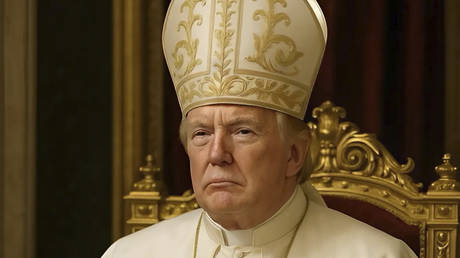 Trump shares image of himself as pope (PHOTO)
Trump shares image of himself as pope (PHOTO)
Trump said First Lady Melania Trump found the image amusing. He then joked, “Actually, I wouldn’t be able to be married, though… To the best of my knowledge, popes aren’t big on getting married, are they?”
Despite Trump’s claim that “Catholics loved it,” some church leaders expressed disapproval.
Bishop Robert Barron said it “was a bad joke that obviously landed very poorly and was seen as offensive by a lot of Catholics.” Cardinal Timothy Dolan, Archbishop of New York, commented, “I hope he didn’t have anything to do with that... It wasn’t good.”
Read more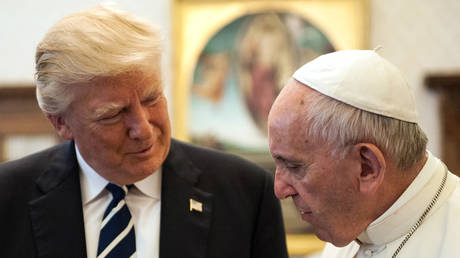 ‘I’d like to be pope’ – Trump
‘I’d like to be pope’ – Trump
Trump and Pope Francis had a long history of disagreement, especially on immigration. In a letter to US Catholic bishops earlier this year, the pope criticized Trump’s mass deportation policies as a “major crisis” that undermines human dignity.
Their tensions date back to 2016, when Francis said anyone who builds walls instead of bridges is “not Christian” – a remark widely interpreted as a rebuke of Trump’s proposed border wall.
President Trump and the First Lady attended Pope Francis’ funeral in Rome on April 26. It was Trump’s first overseas trip since returning to office in January. The Vatican has confirmed that the papal conclave to elect a new pope will begin on May 8.
-
Site: RT - News
The US president insists Catholics “loved” the joke
President Donald Trump has dismissed criticism over a viral AI-generated image depicting him in papal attire, insisting the backlash is being driven by the “fake news media,” not the Catholic community.
The digitally altered image, which shows Trump wearing a white papal robe, gold crucifix, and mitre, was posted on his Truth Social platform and the official White House account on X on Saturday. The post followed Trump’s recent remarks joking about becoming the next pope after Pope Francis’ death on April 21.
The image sparked mixed reactions online, with some finding it humorous and others calling it inappropriate. Addressing the controversy on Monday, Trump rejected claims that Catholics were offended.
“Oh, I see. You mean they can’t take a joke? You don’t mean the Catholics, you mean the fake news media. The Catholics loved it,” Trump told reporters at the White House.
FOX NEWS: Some Catholics were not so happy about the image of you looking like the Pope
— Aaron Rupar (@atrupar) May 5, 2025
TRUMP: You mean they can't take a joke? You don't mean the Catholics, you mean the fake news media. The Catholics loved it. I had nothing to do with it. Maybe it was AI. pic.twitter.com/6dvyhGTLHQHe added that he had no role in sharing the image: “Somebody made up a picture of me dressed like the Pope, and they put it out on the internet. That’s not me that did it. I have no idea where it came from. Maybe it was AI, but I know nothing about it. I just saw it last evening.”
Read more Trump shares image of himself as pope (PHOTO)
Trump shares image of himself as pope (PHOTO)
Trump said First Lady Melania Trump found the image amusing. He then joked, “Actually, I wouldn’t be able to be married, though… To the best of my knowledge, popes aren’t big on getting married, are they?”
Despite Trump’s claim that “Catholics loved it,” some church leaders expressed disapproval.
Bishop Robert Barron said it “was a bad joke that obviously landed very poorly and was seen as offensive by a lot of Catholics.” Cardinal Timothy Dolan, Archbishop of New York, commented, “I hope he didn’t have anything to do with that... It wasn’t good.”
Read more ‘I’d like to be pope’ – Trump
‘I’d like to be pope’ – Trump
Trump and Pope Francis had a long history of disagreement, especially on immigration. In a letter to US Catholic bishops earlier this year, the pope criticized Trump’s mass deportation policies as a “major crisis” that undermines human dignity.
Their tensions date back to 2016, when Francis said anyone who builds walls instead of bridges is “not Christian” – a remark widely interpreted as a rebuke of Trump’s proposed border wall.
President Trump and the First Lady attended Pope Francis’ funeral in Rome on April 26. It was Trump’s first overseas trip since returning to office in January. The Vatican has confirmed that the papal conclave to elect a new pope will begin on May 8.



